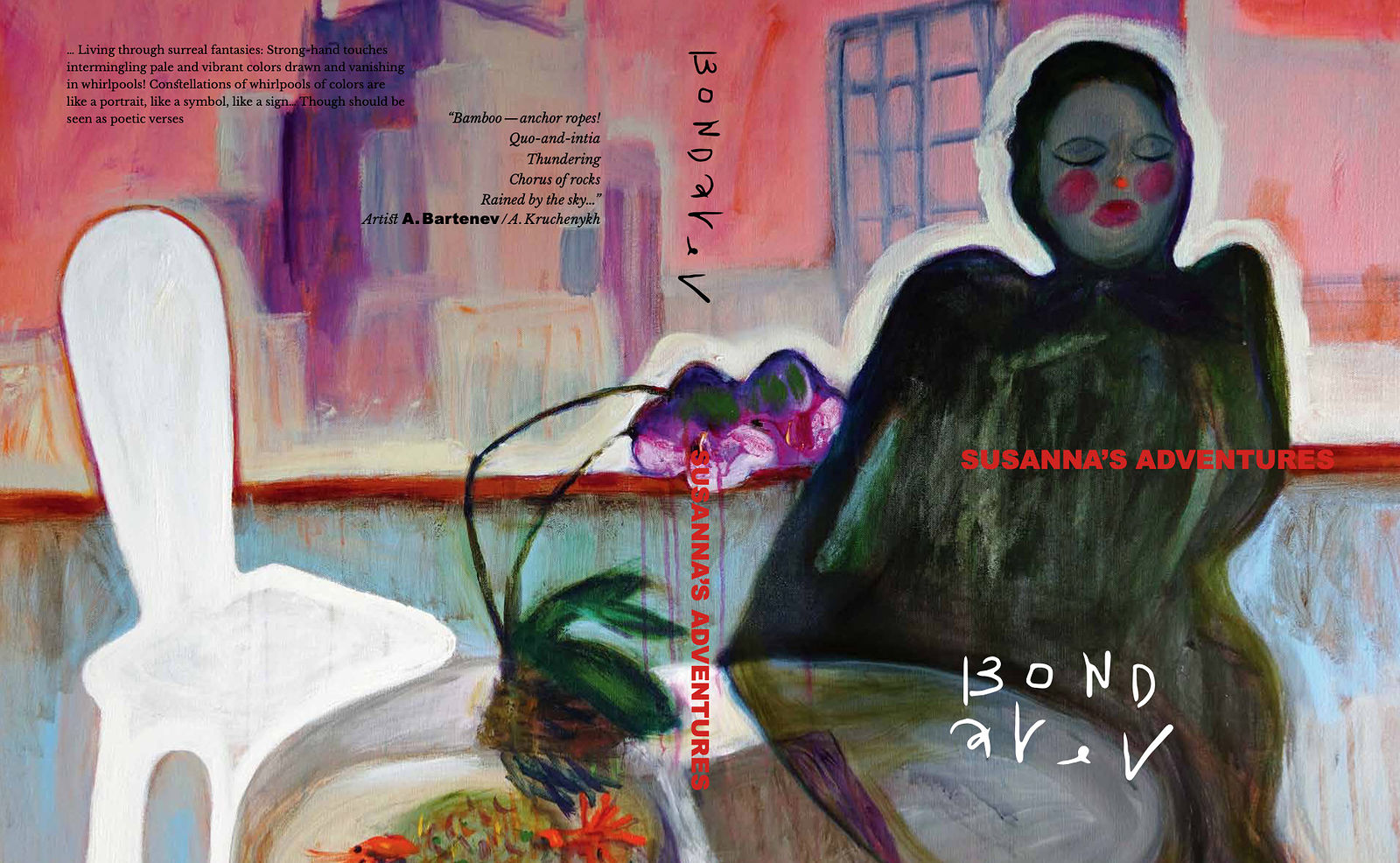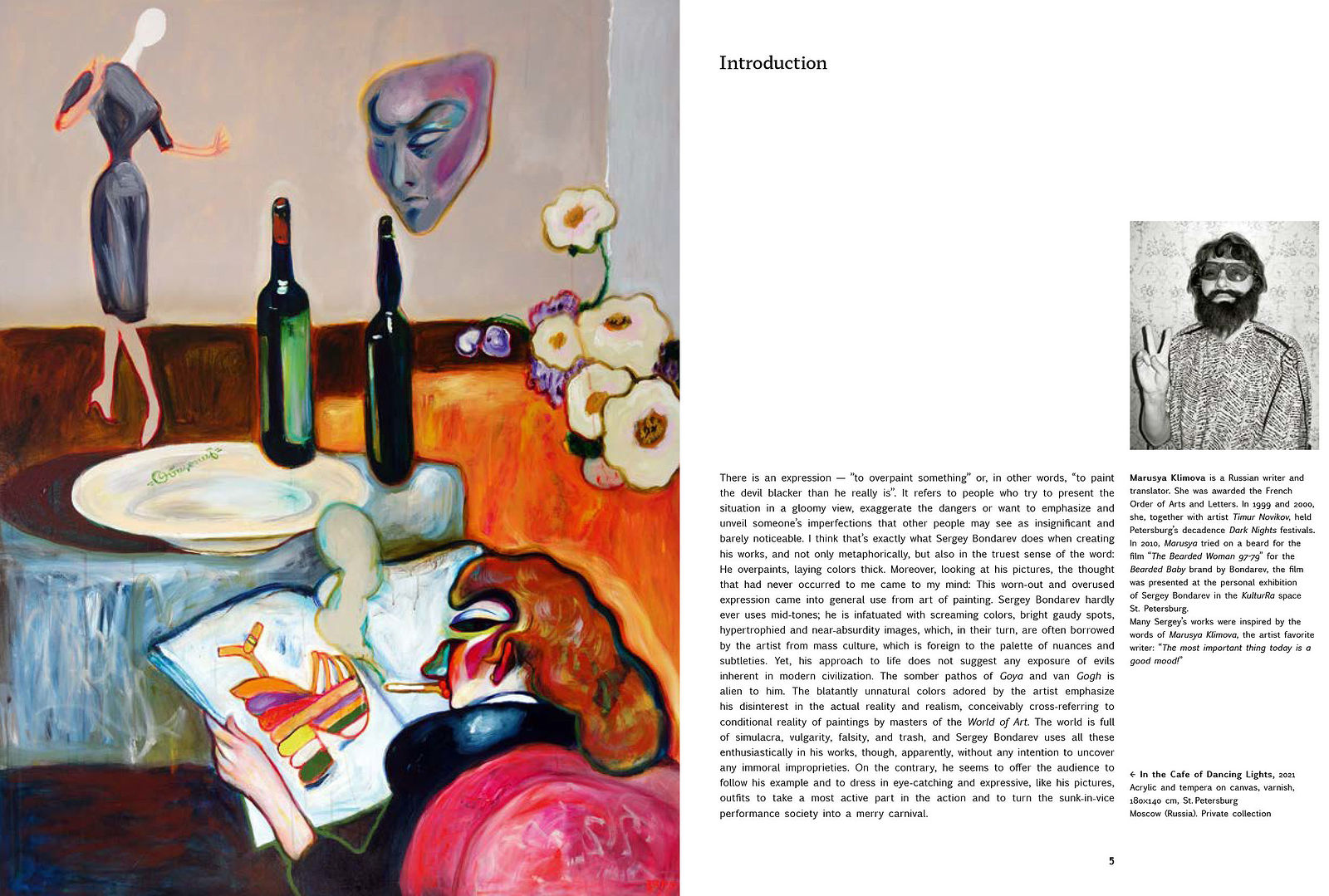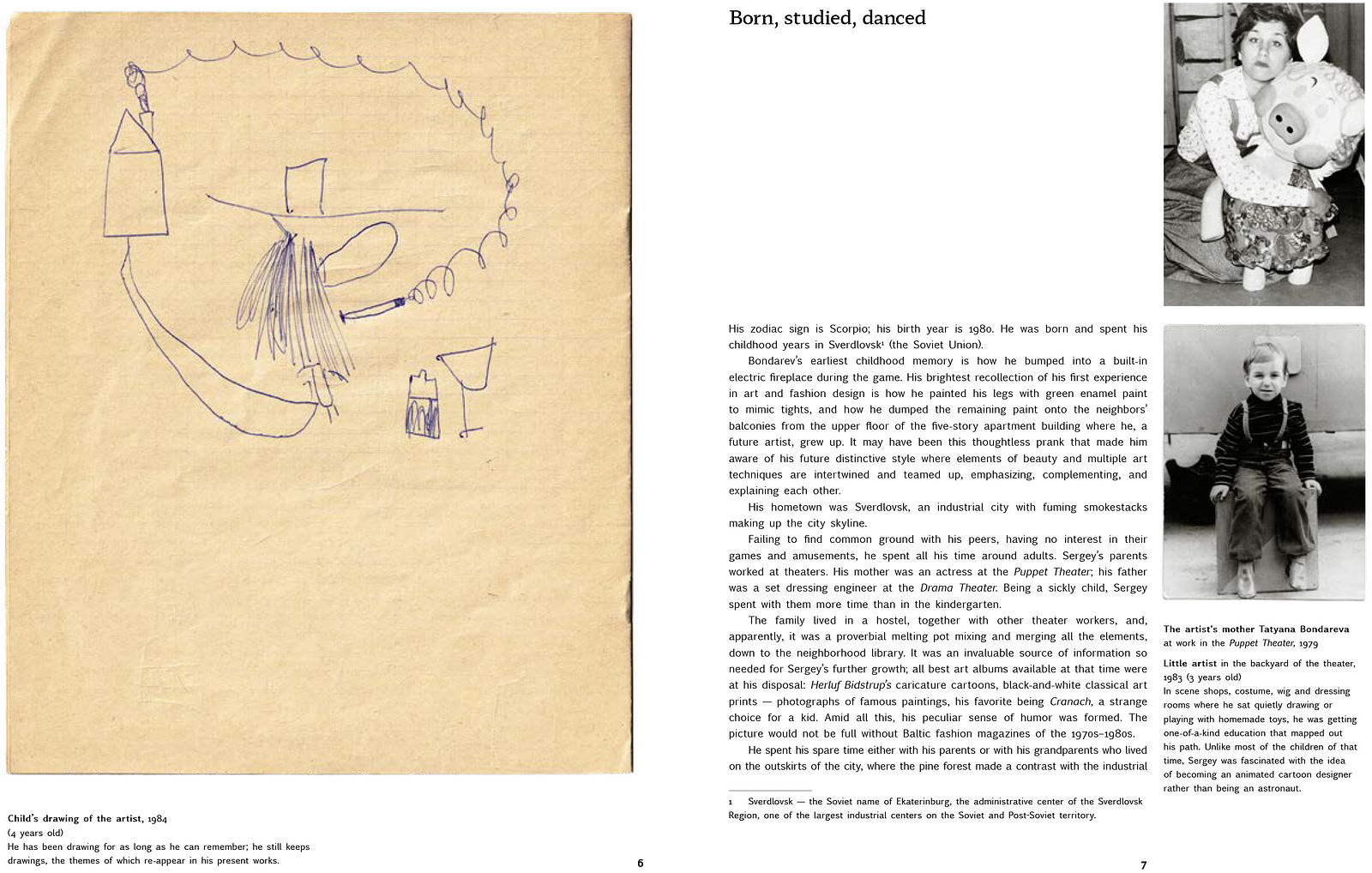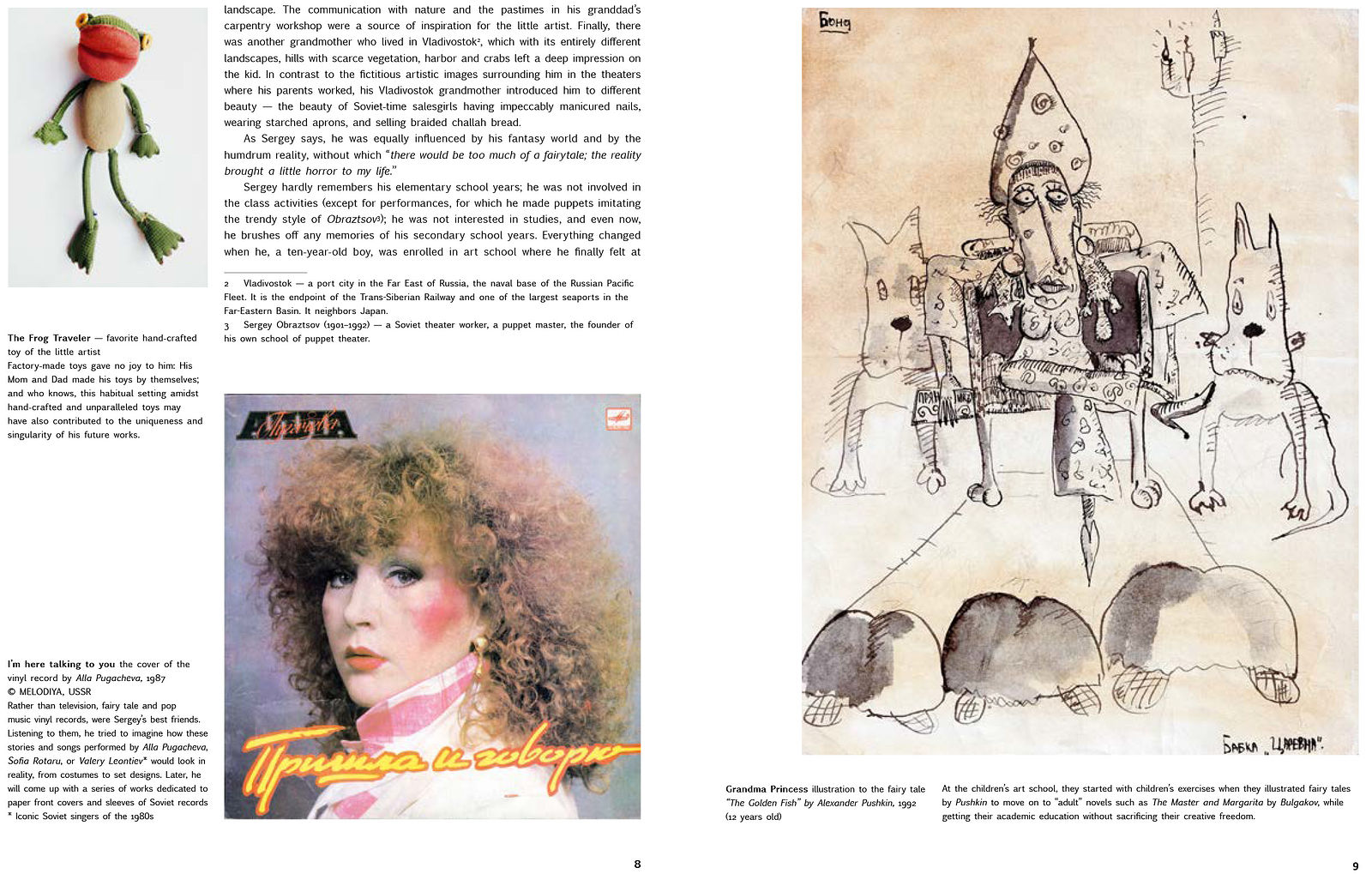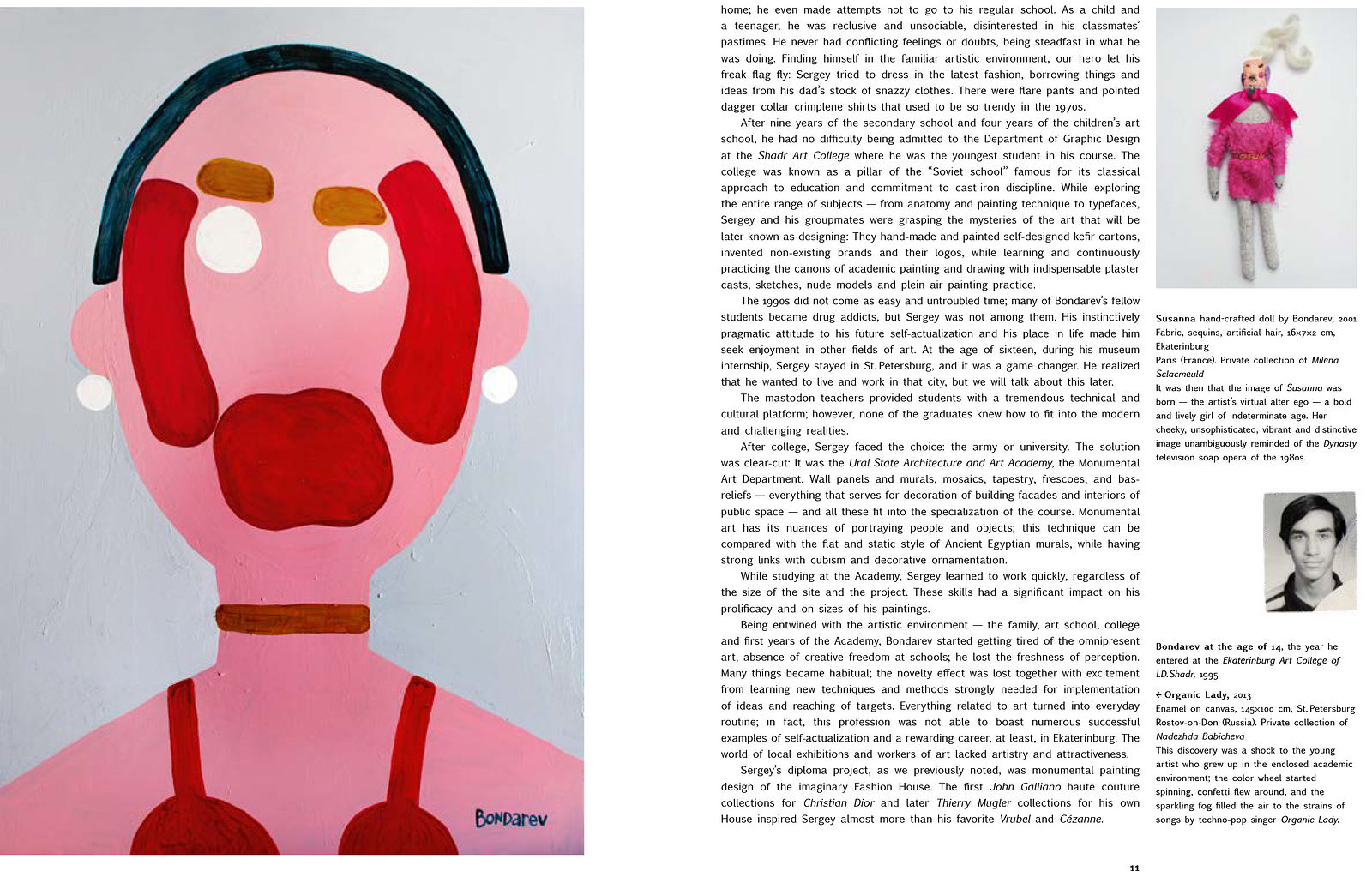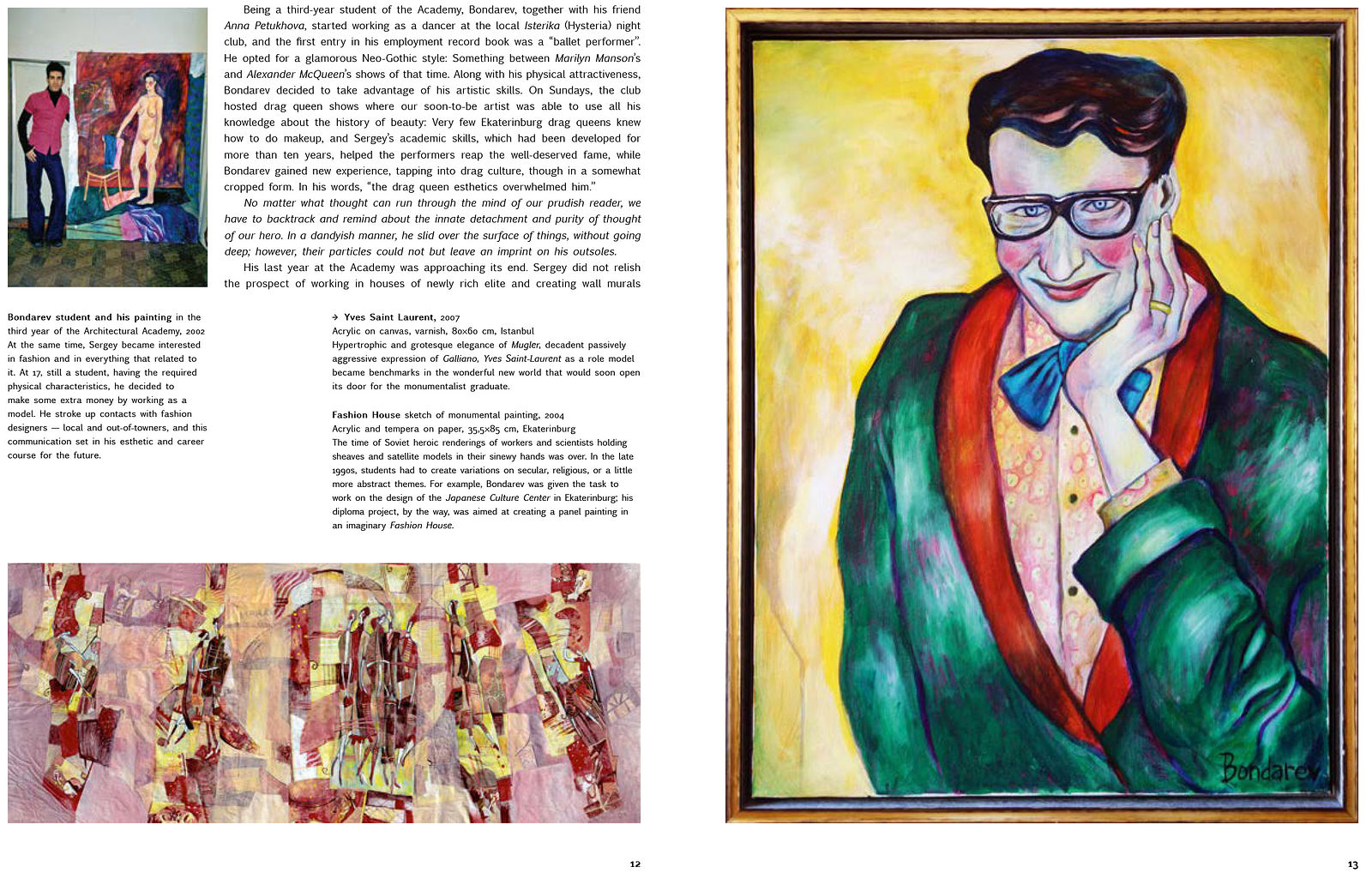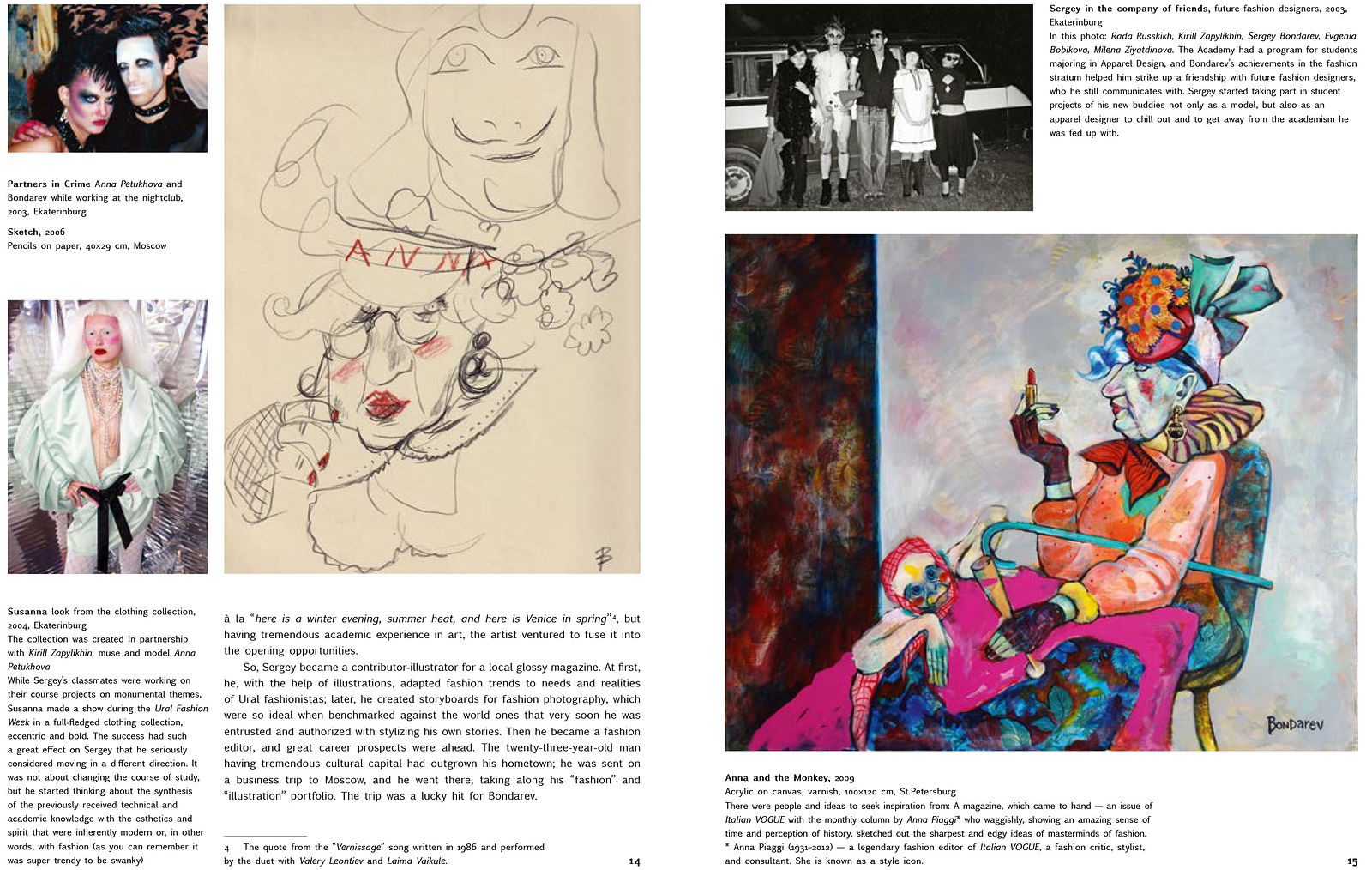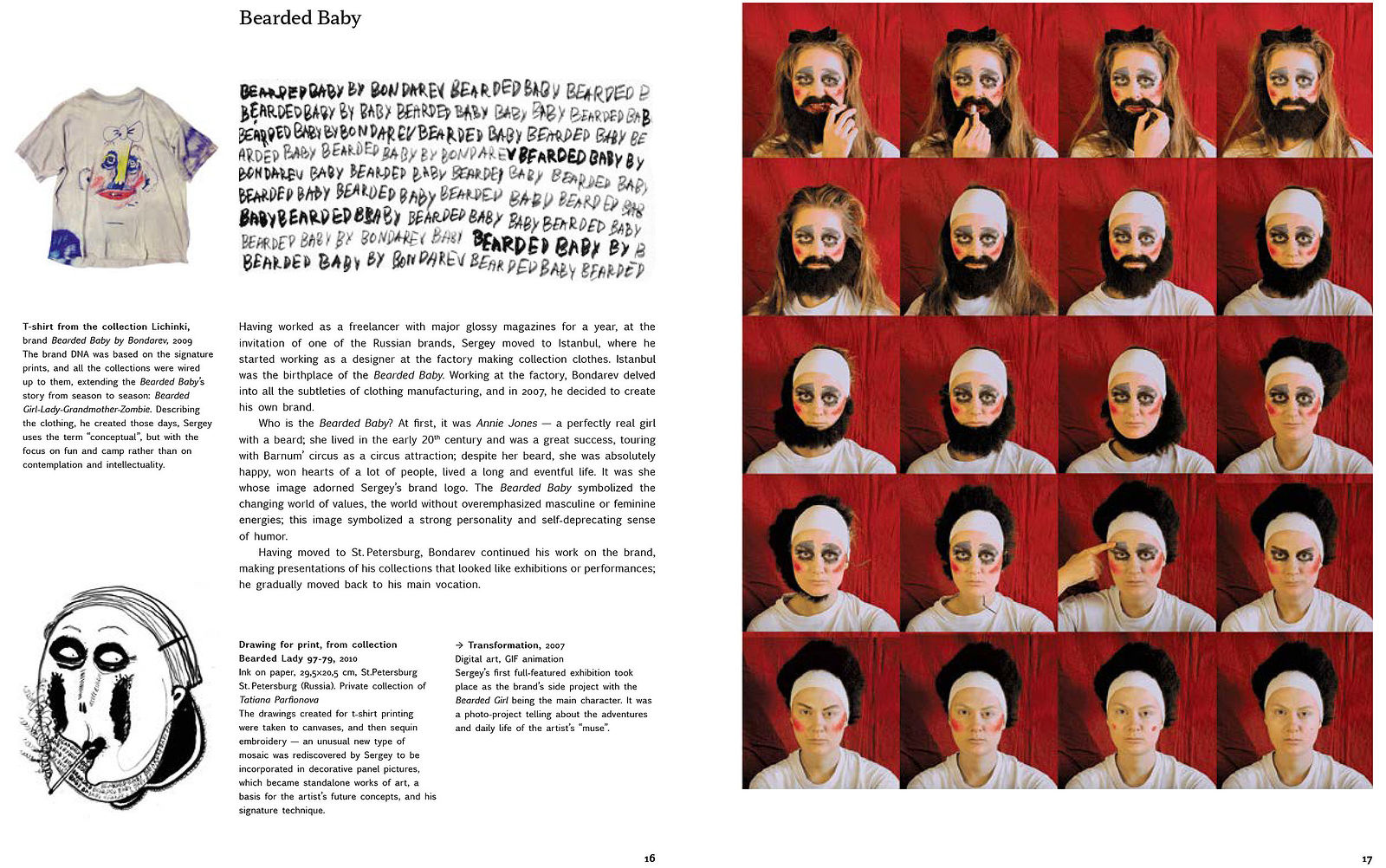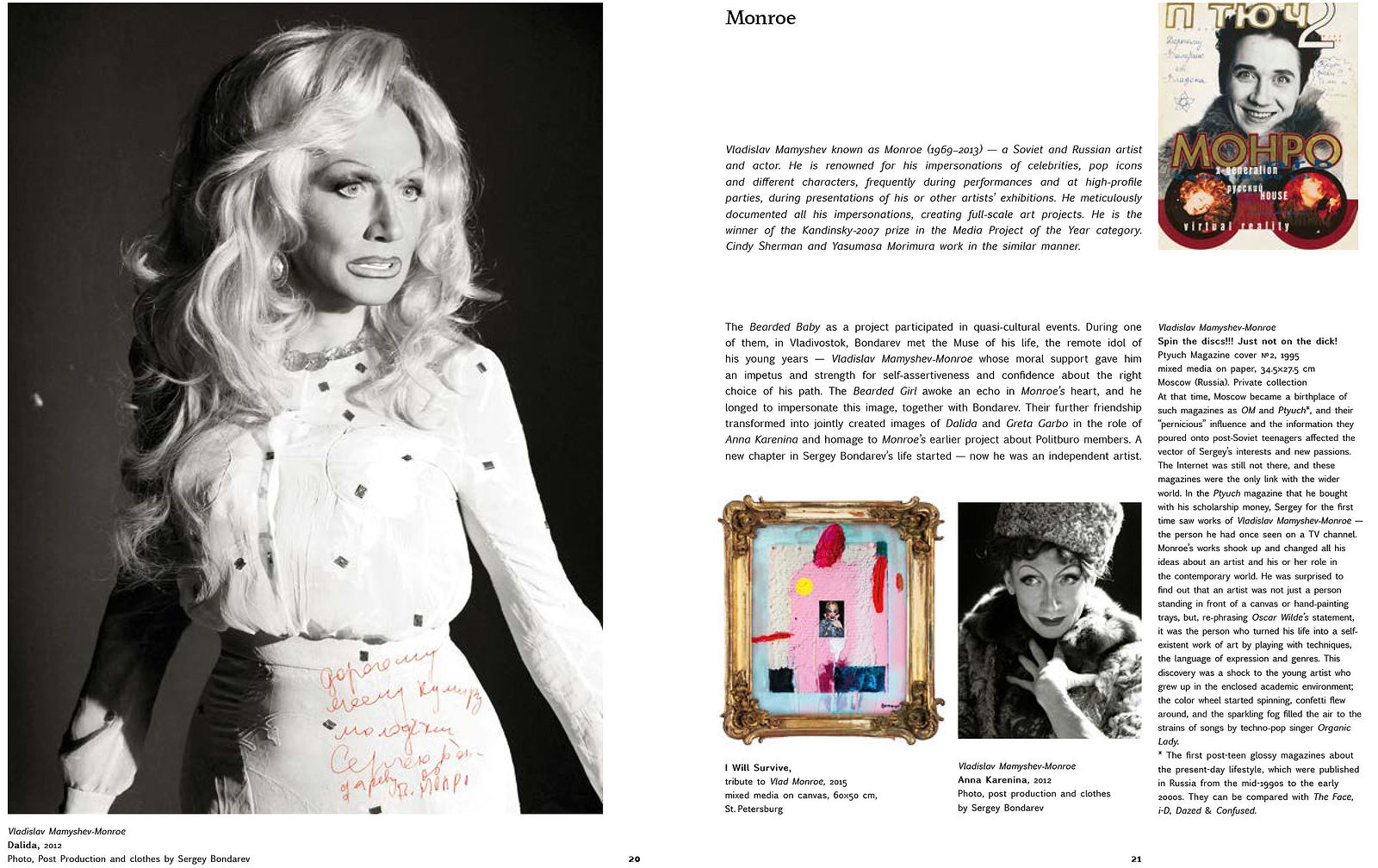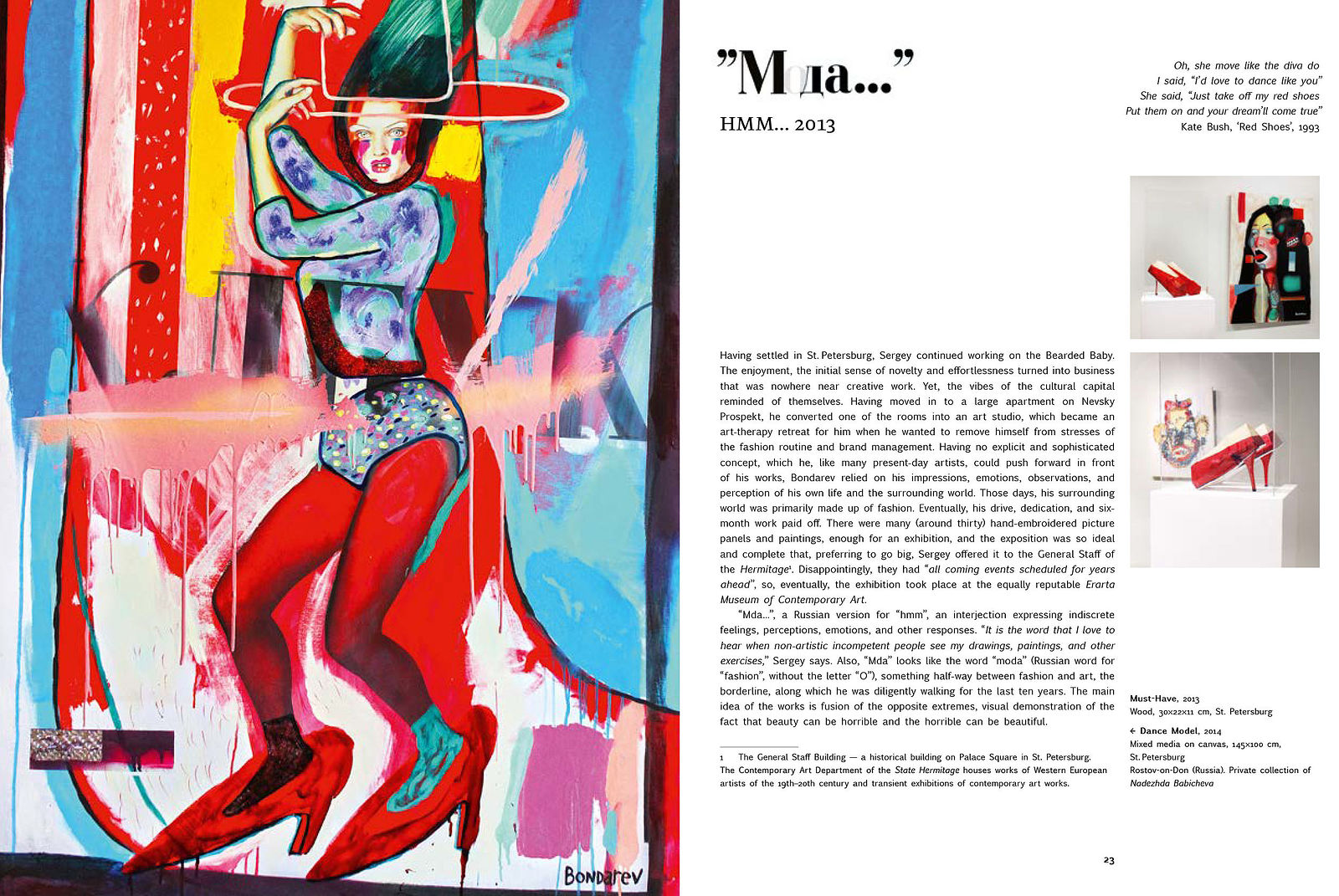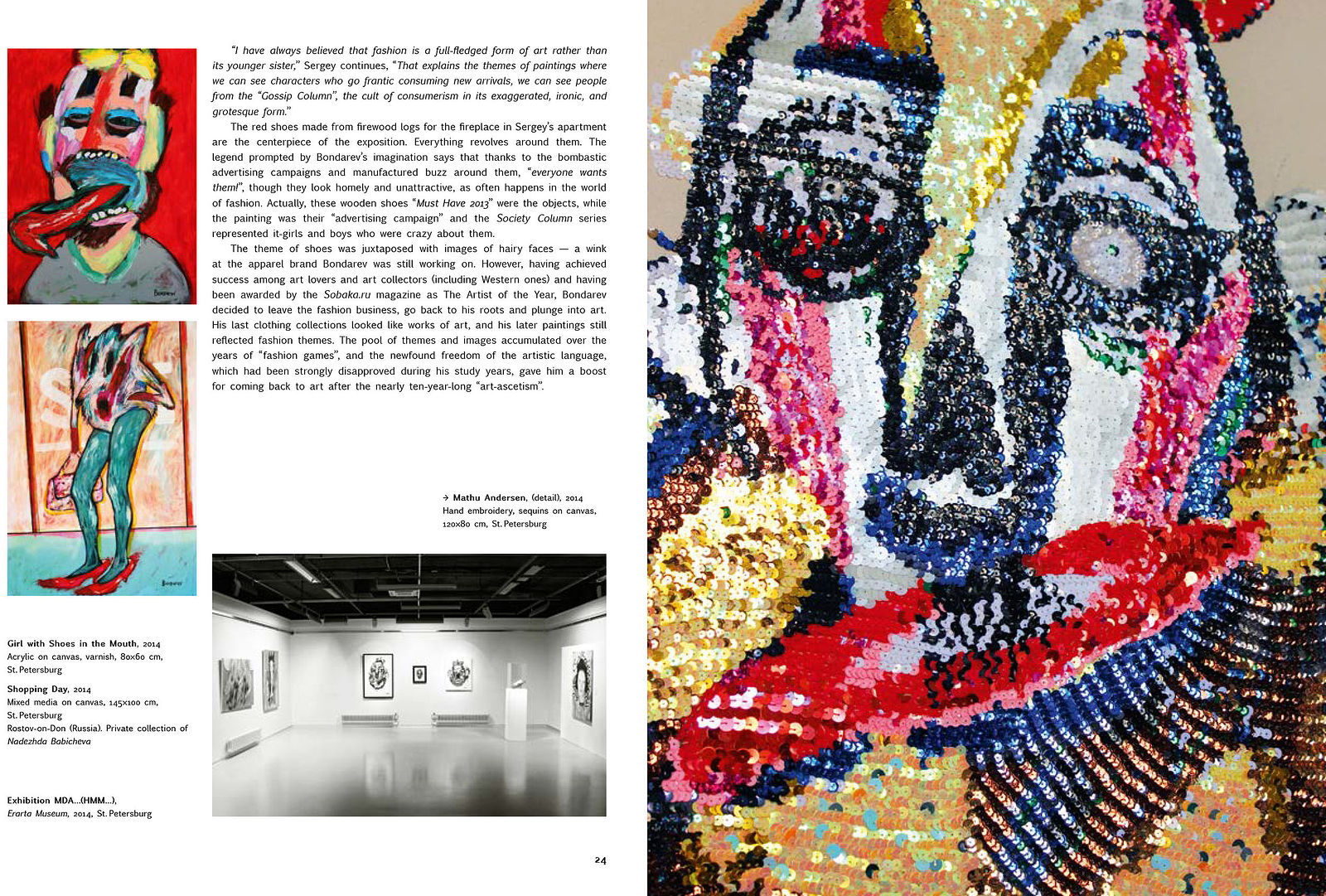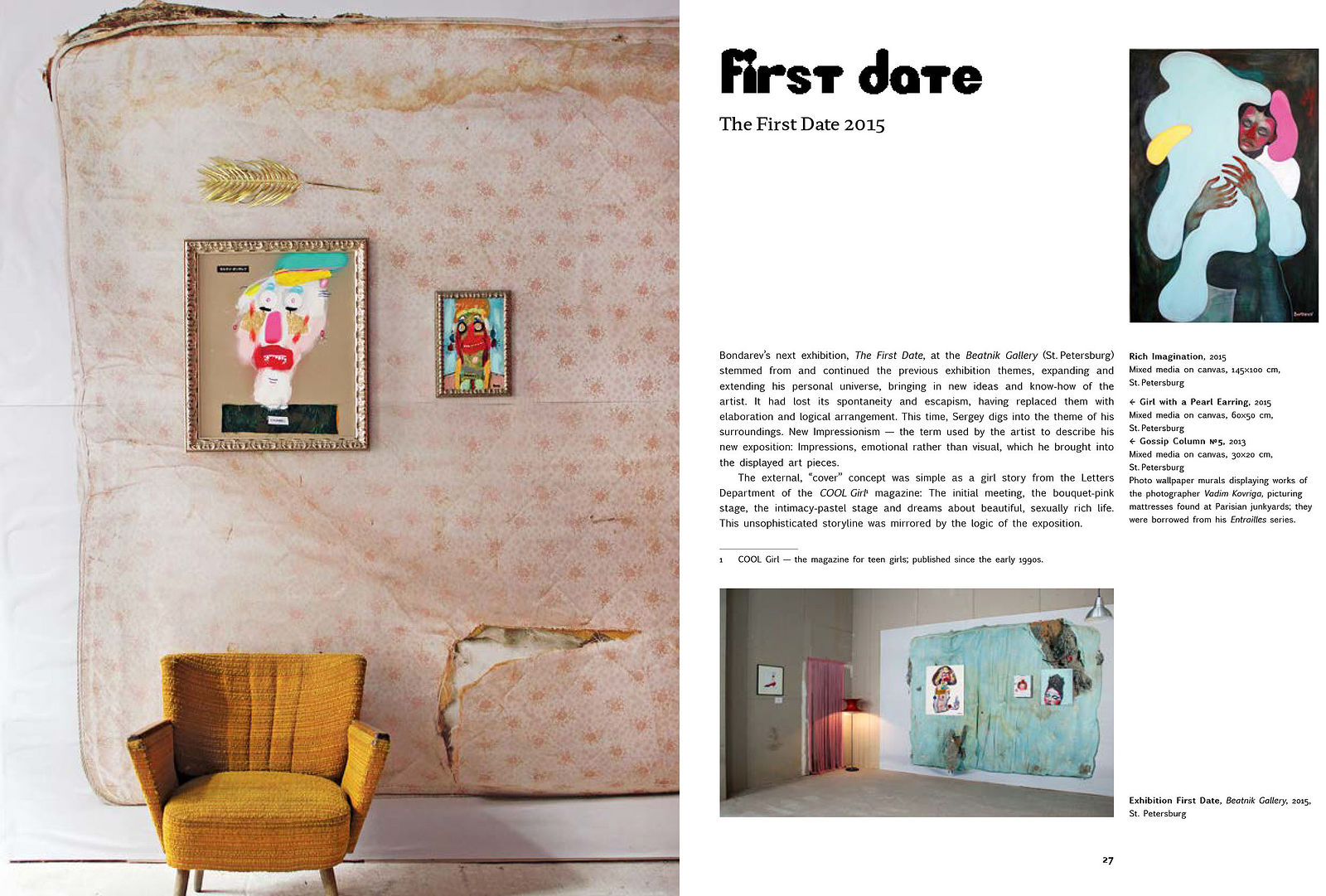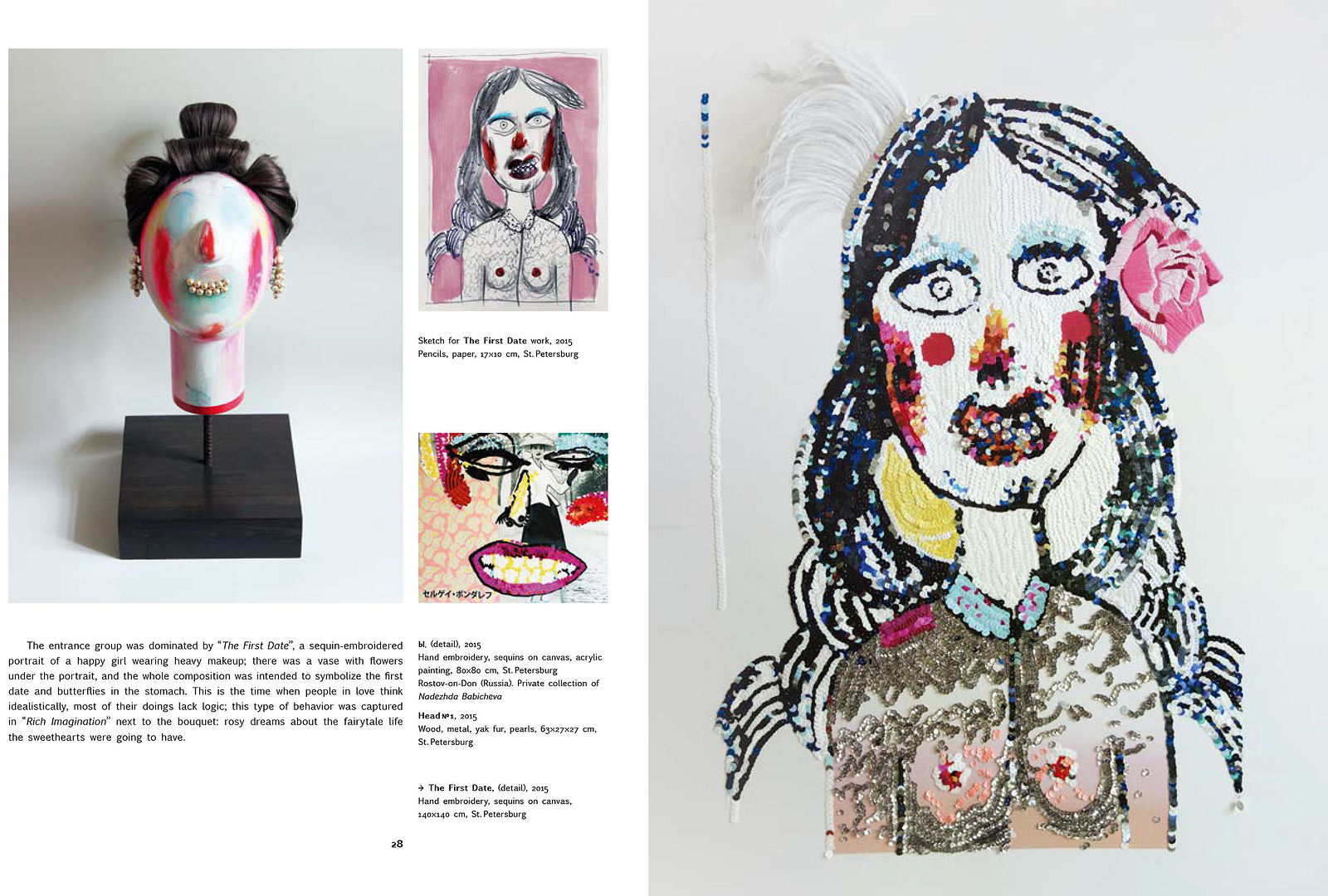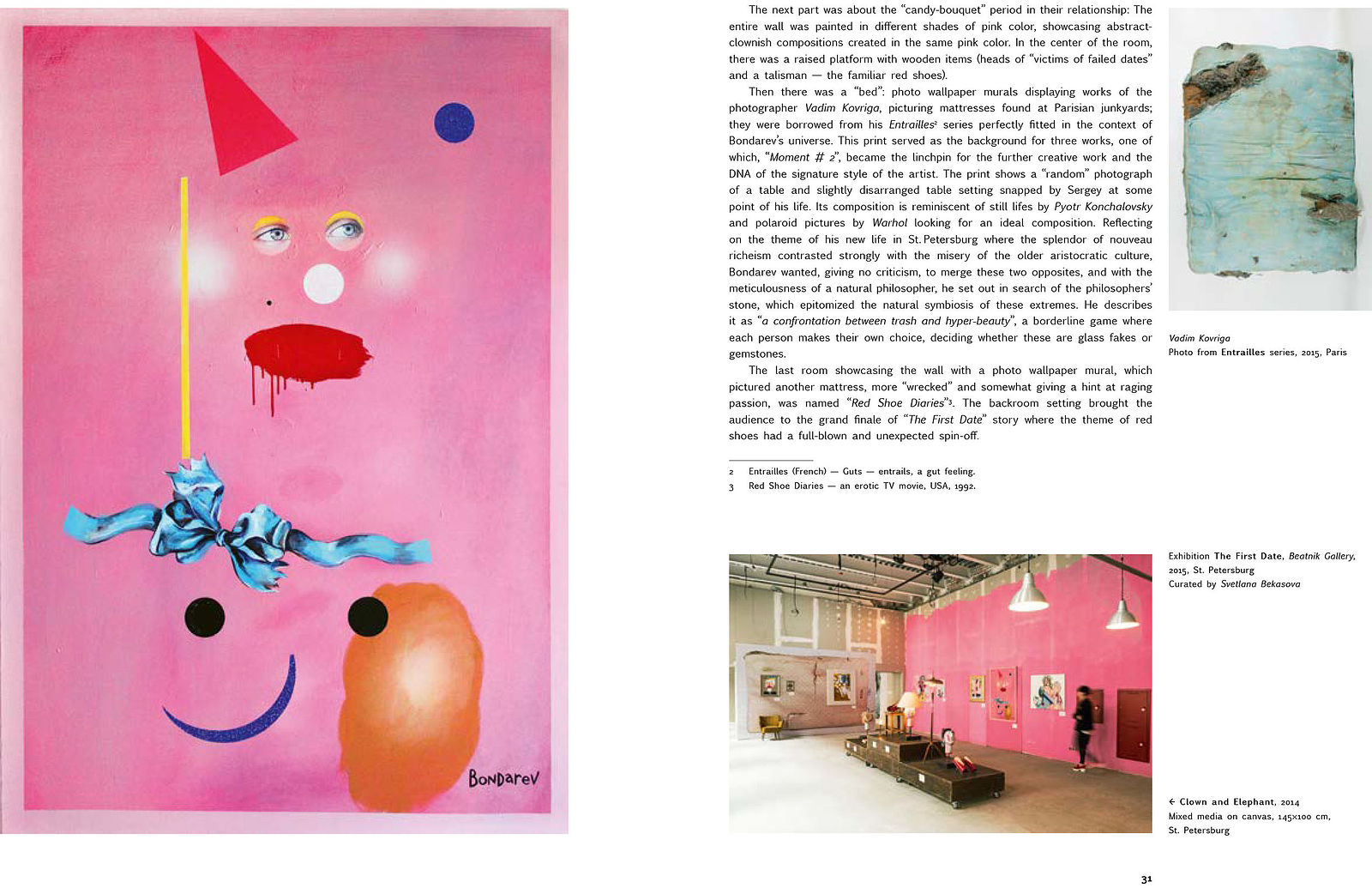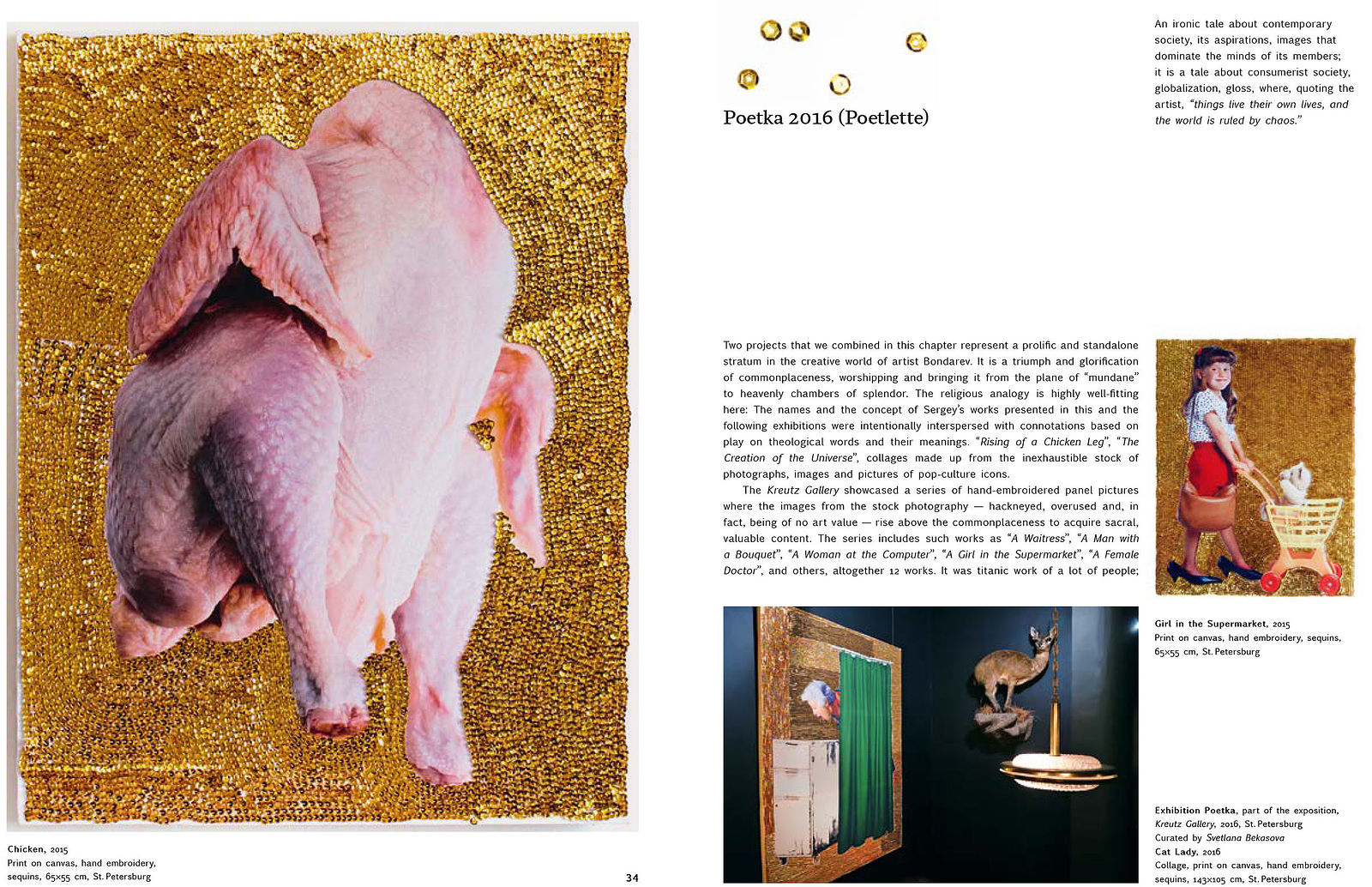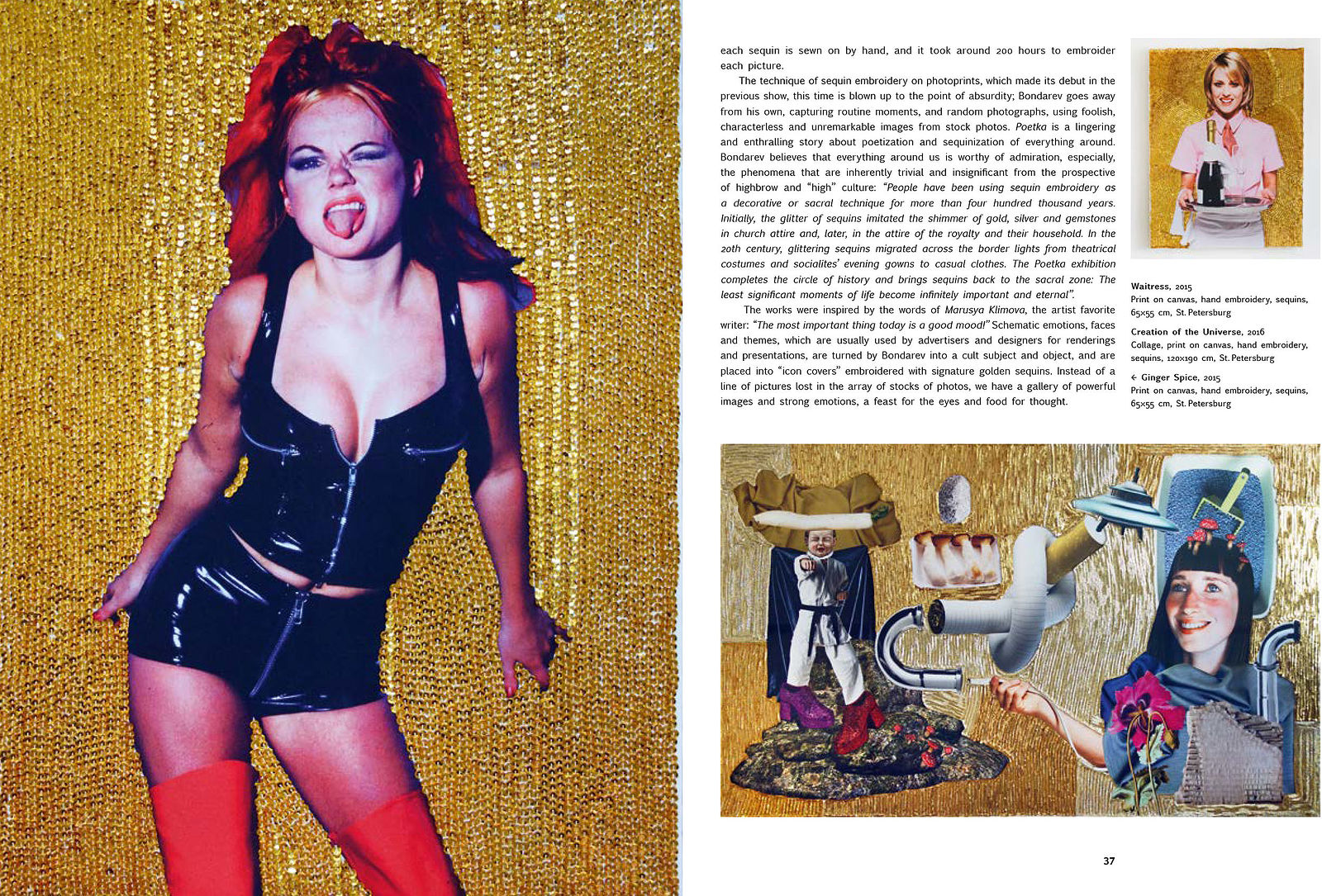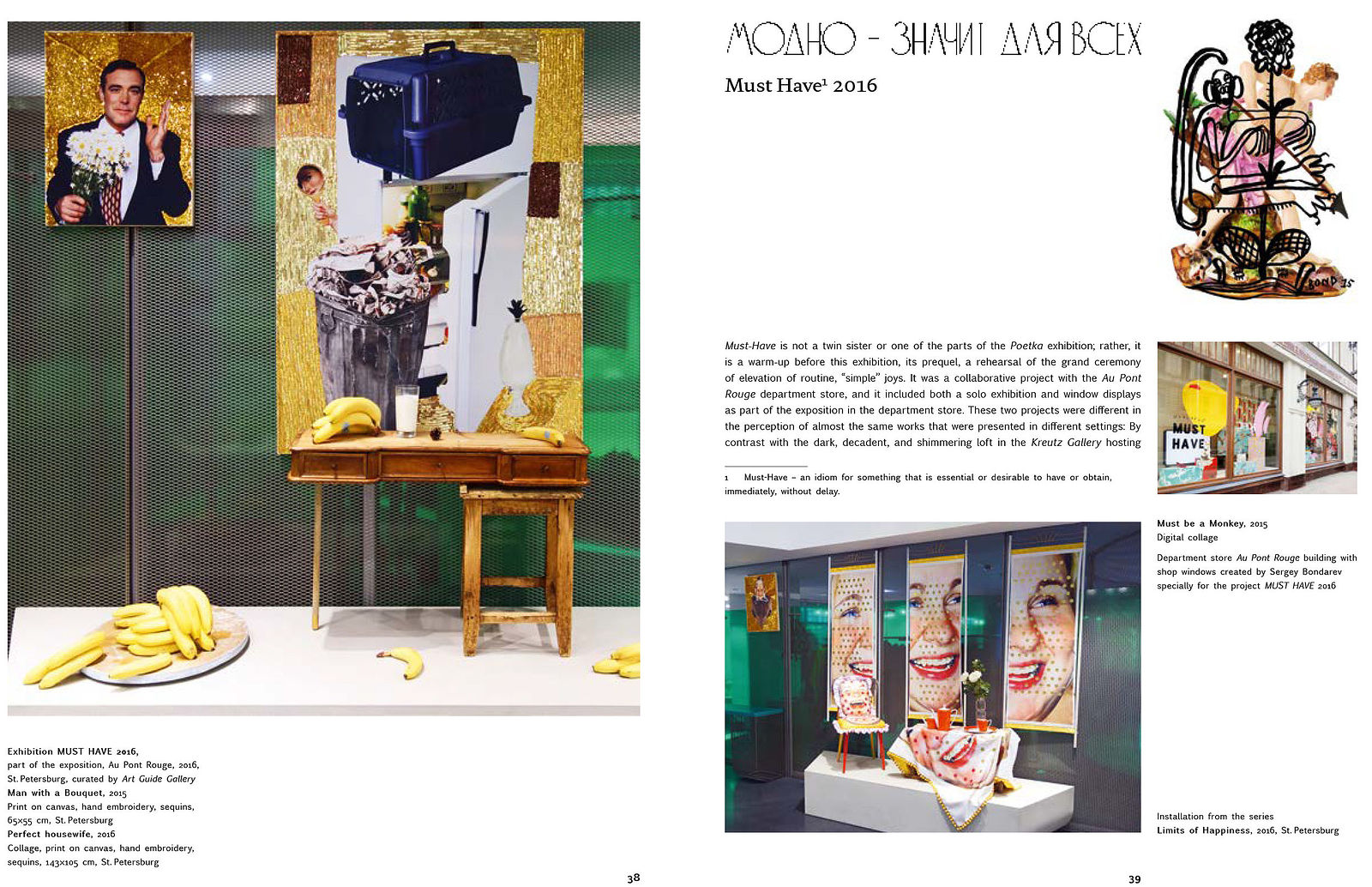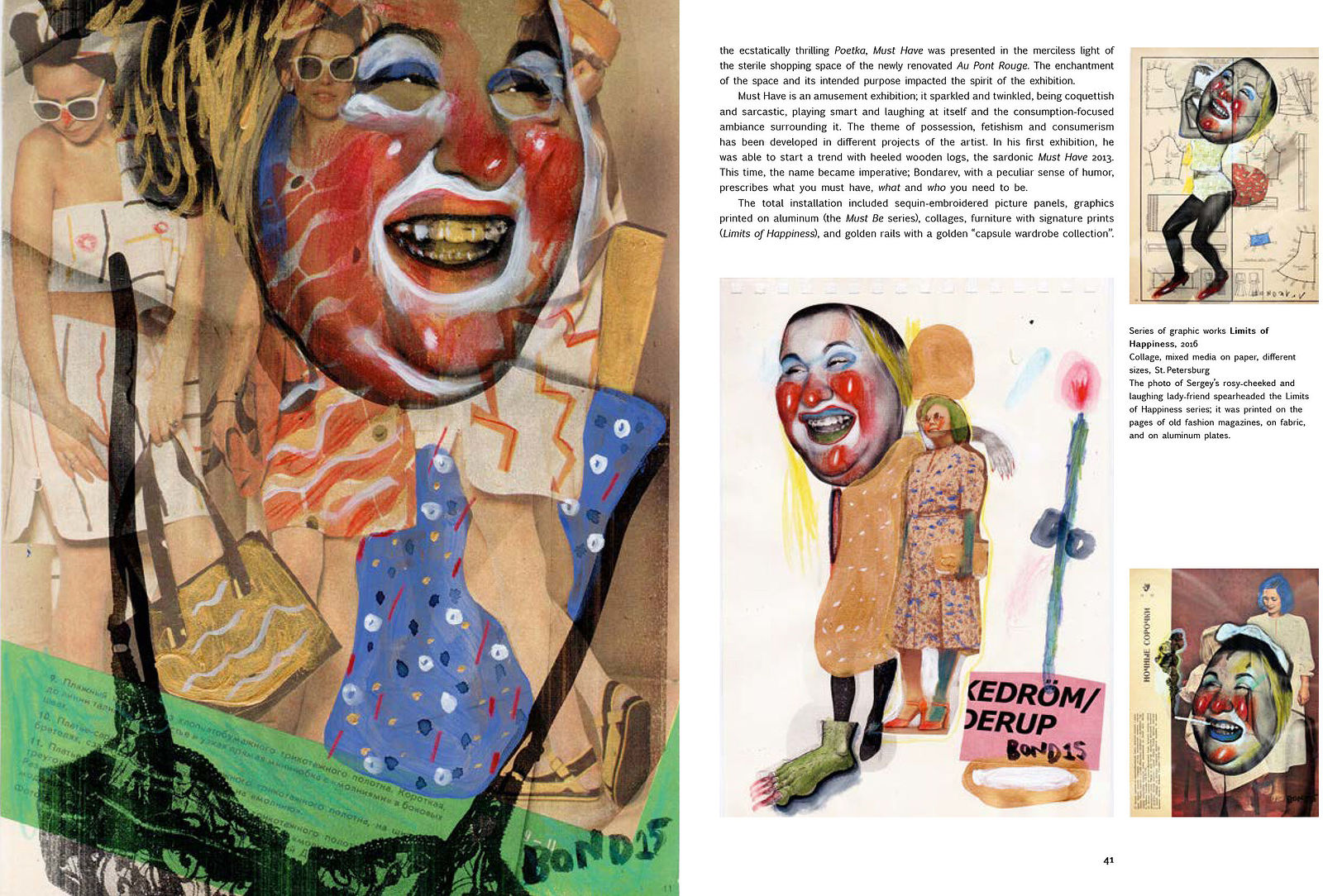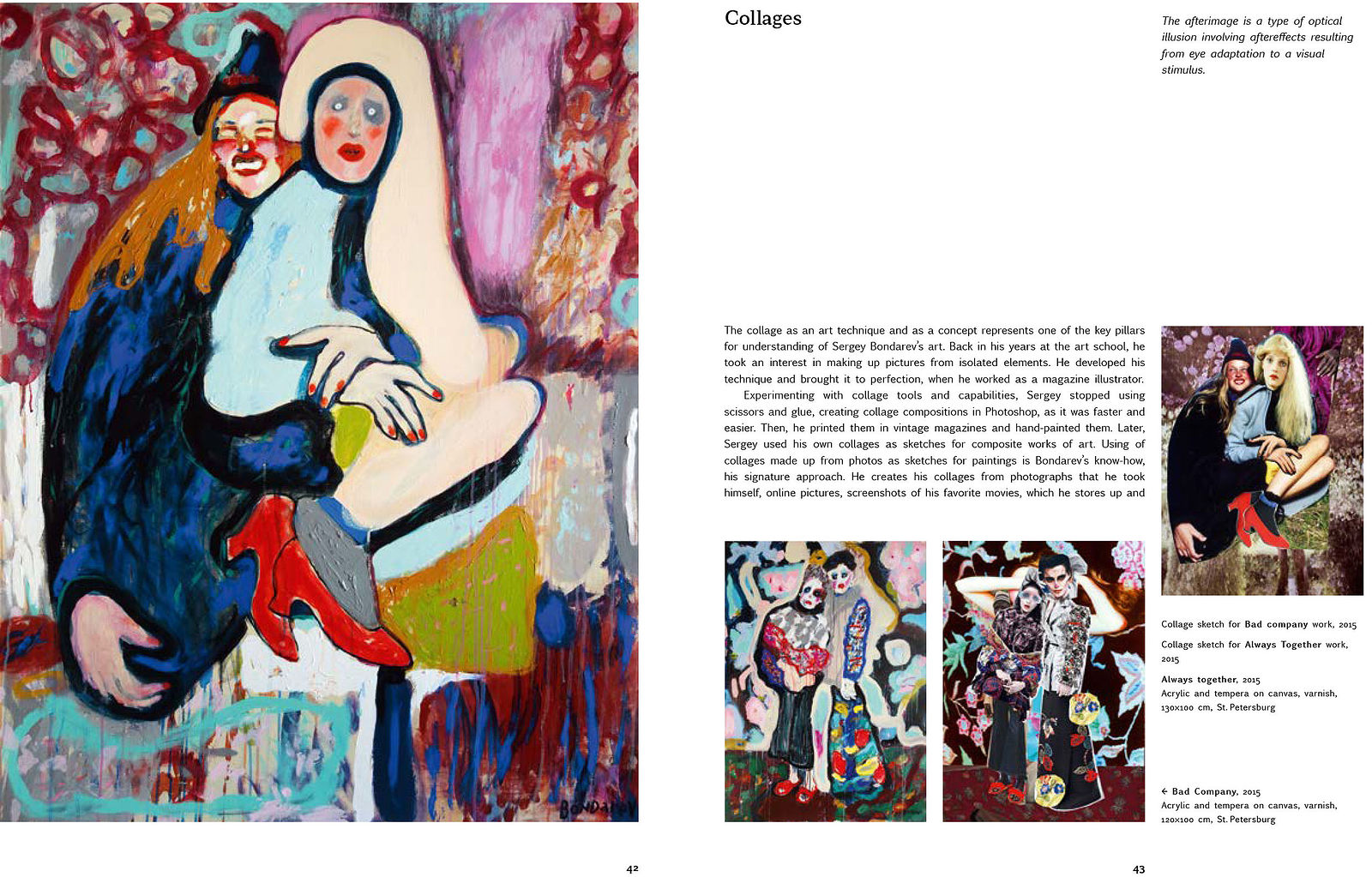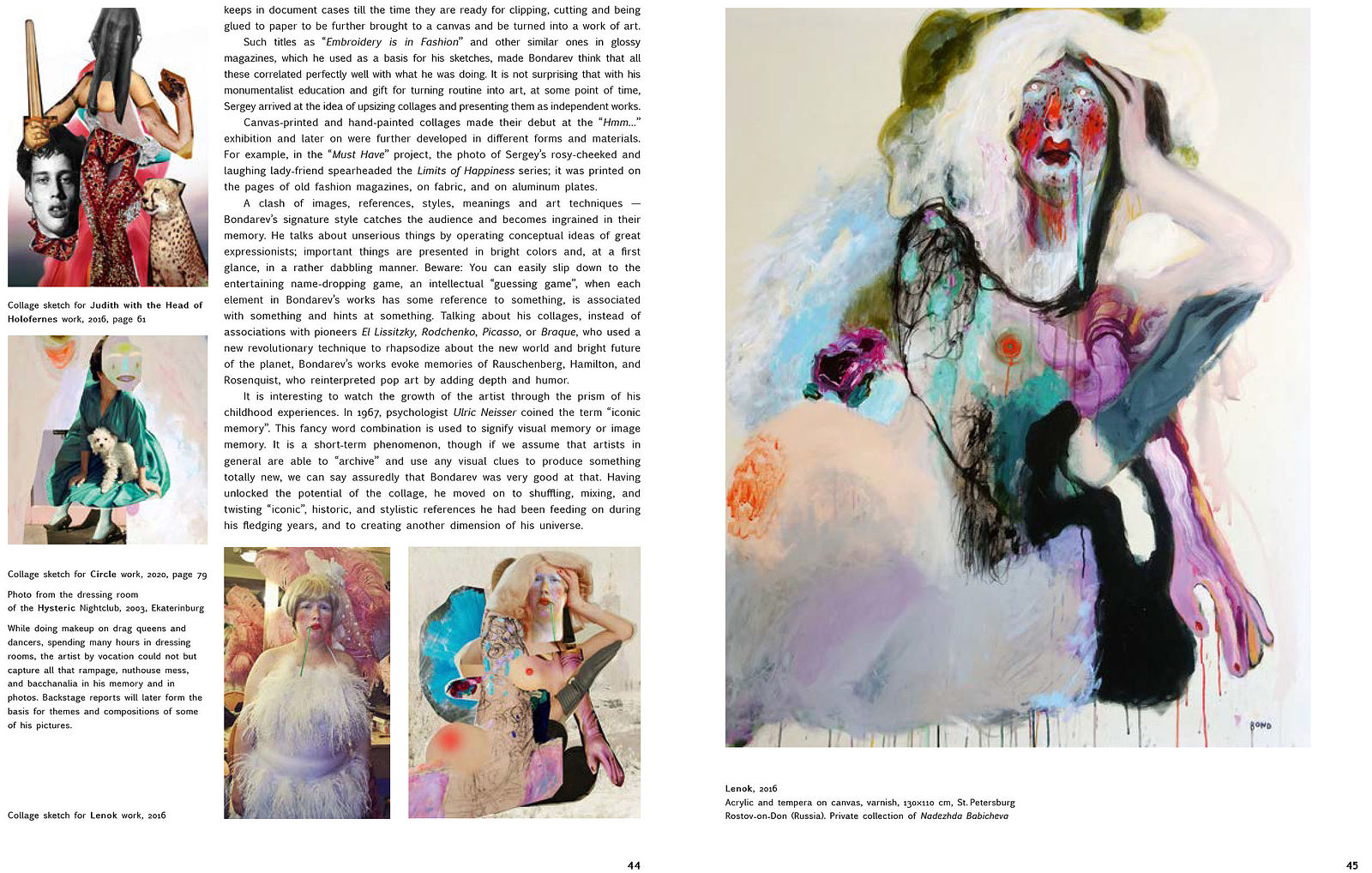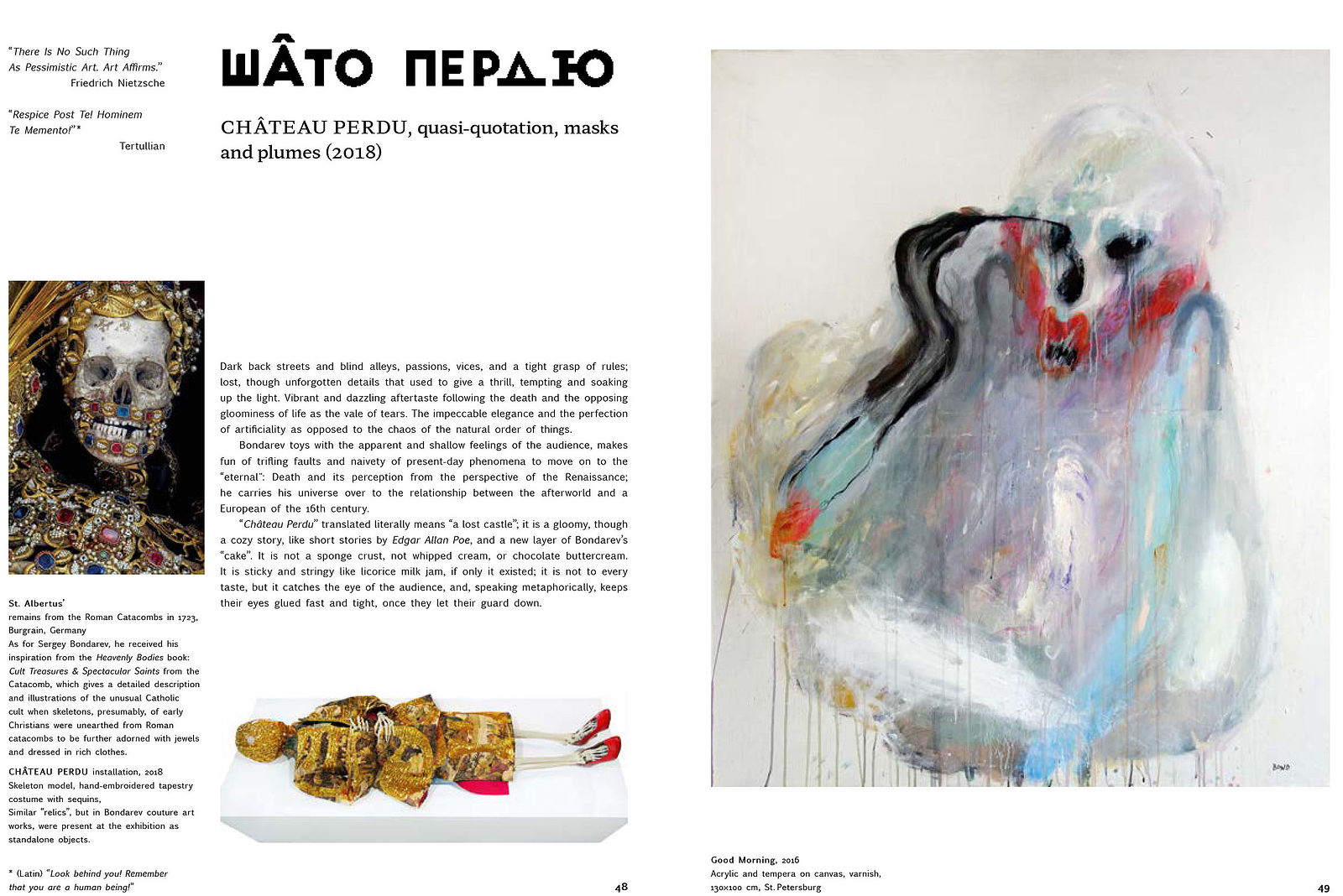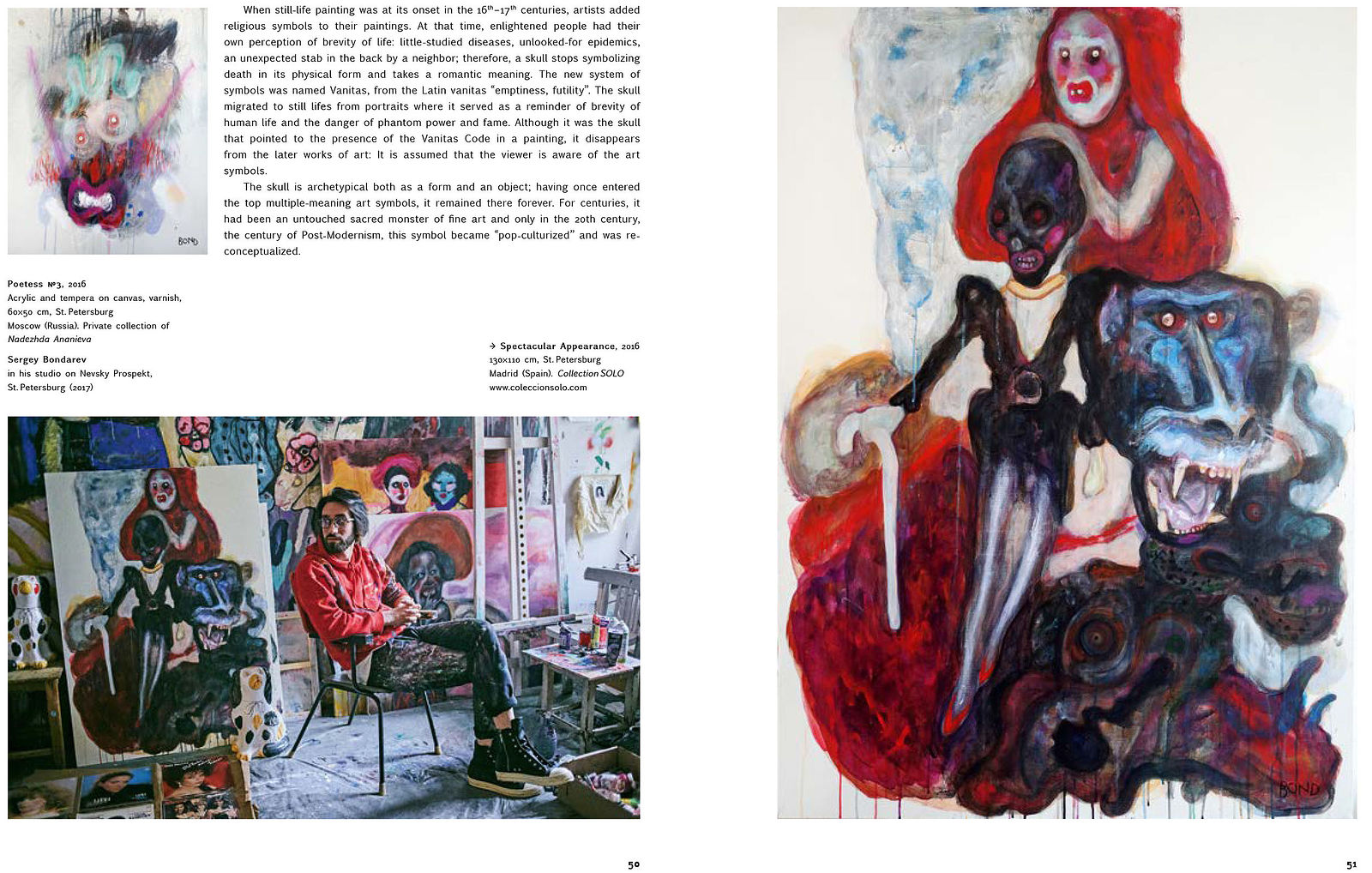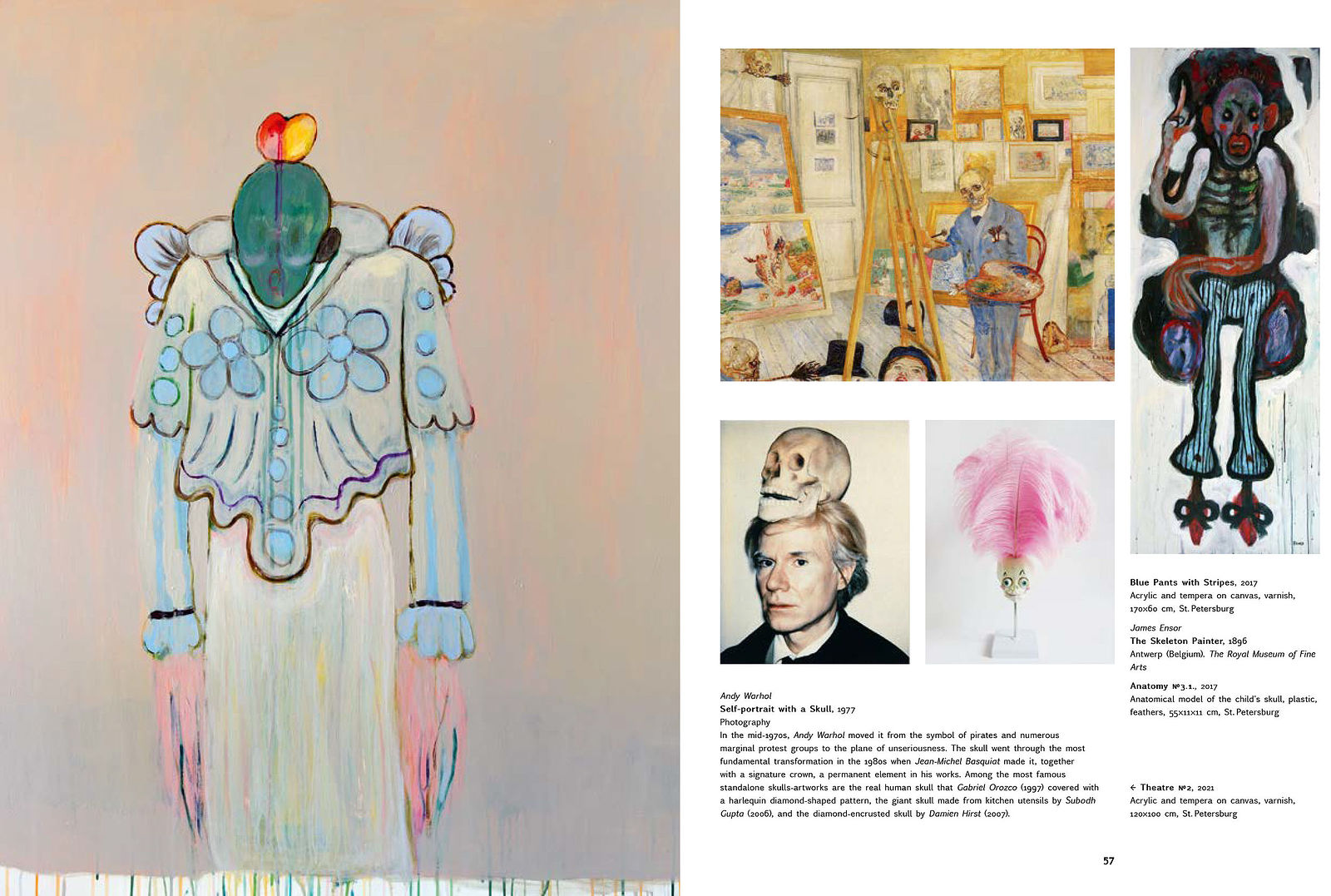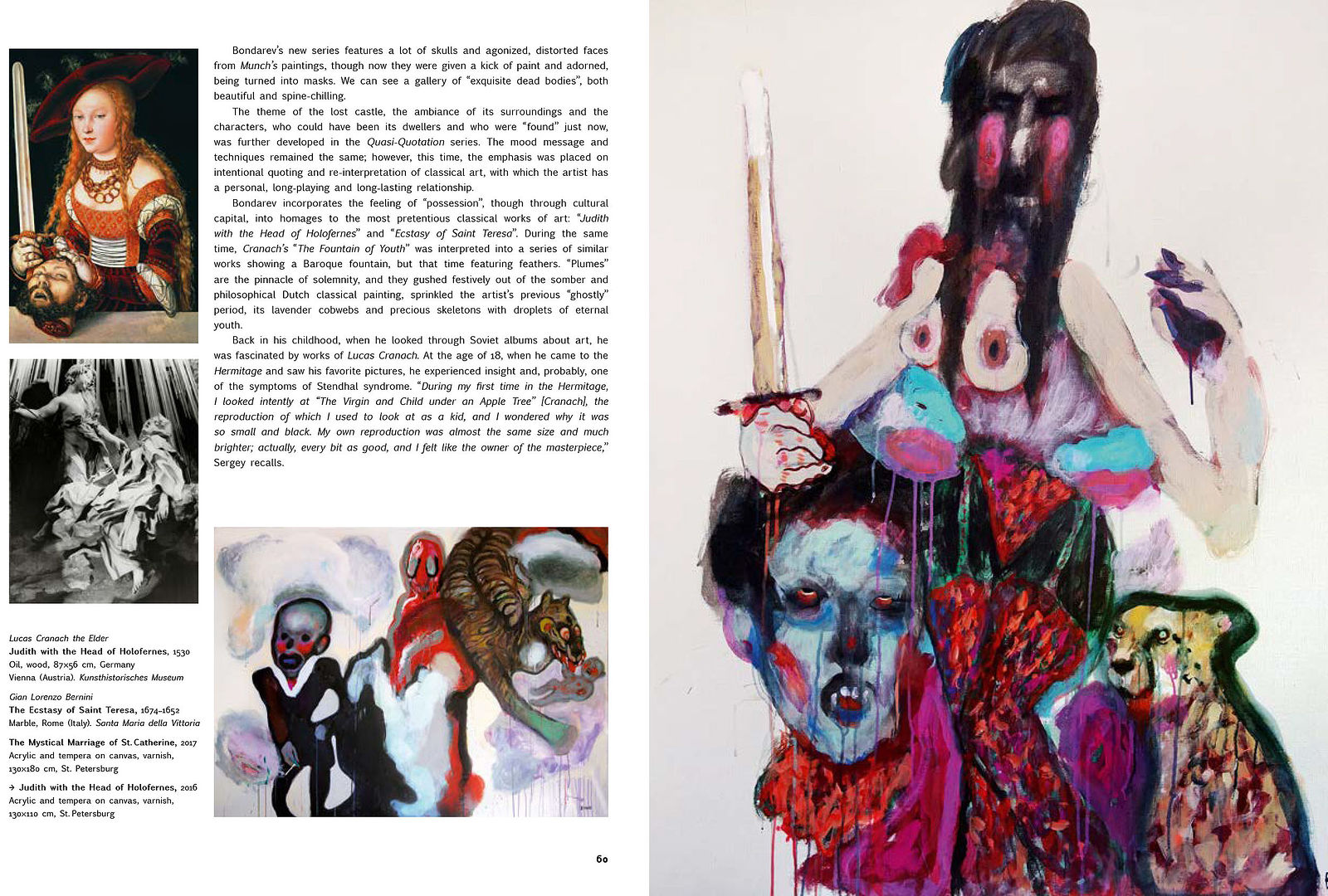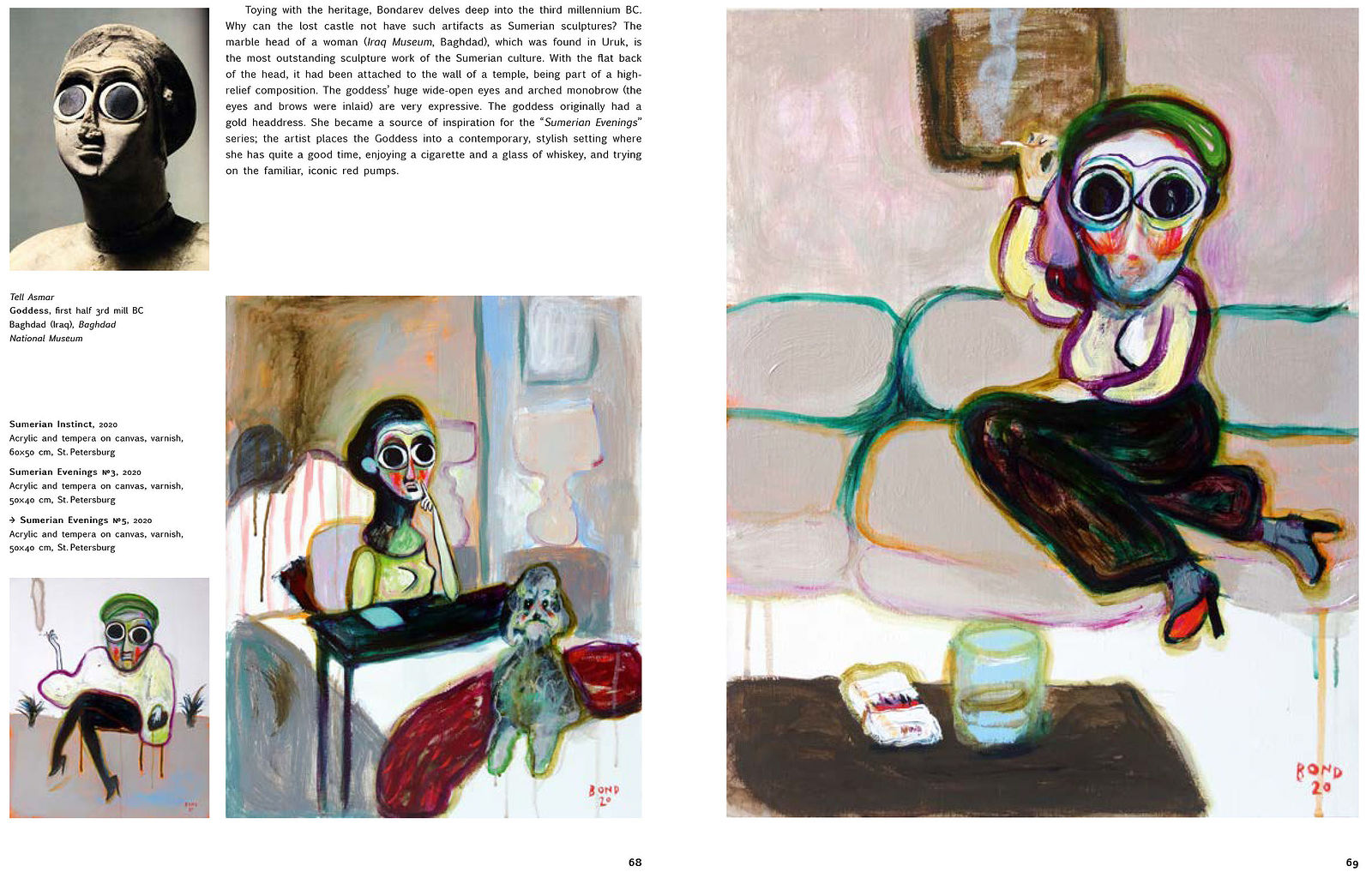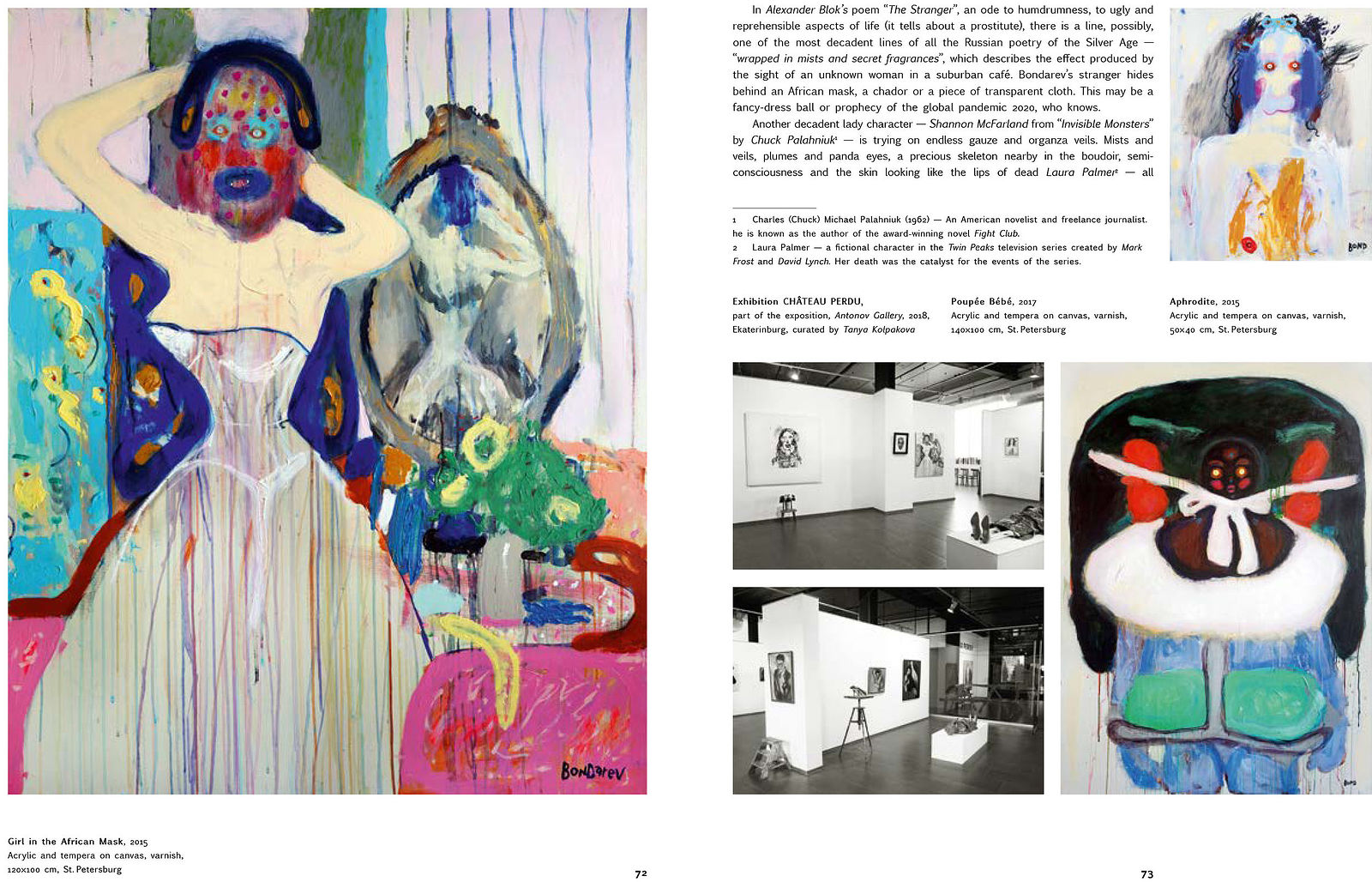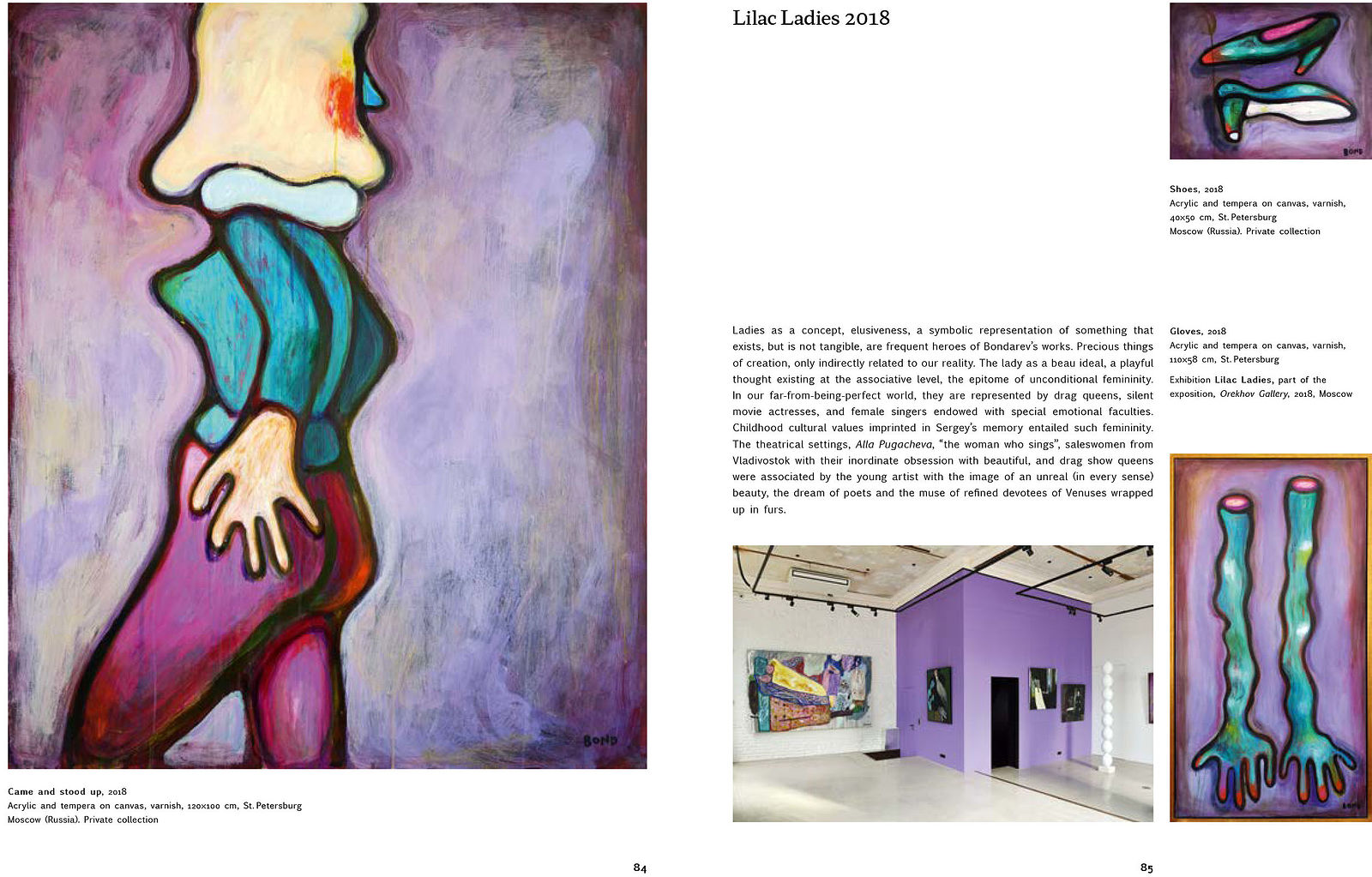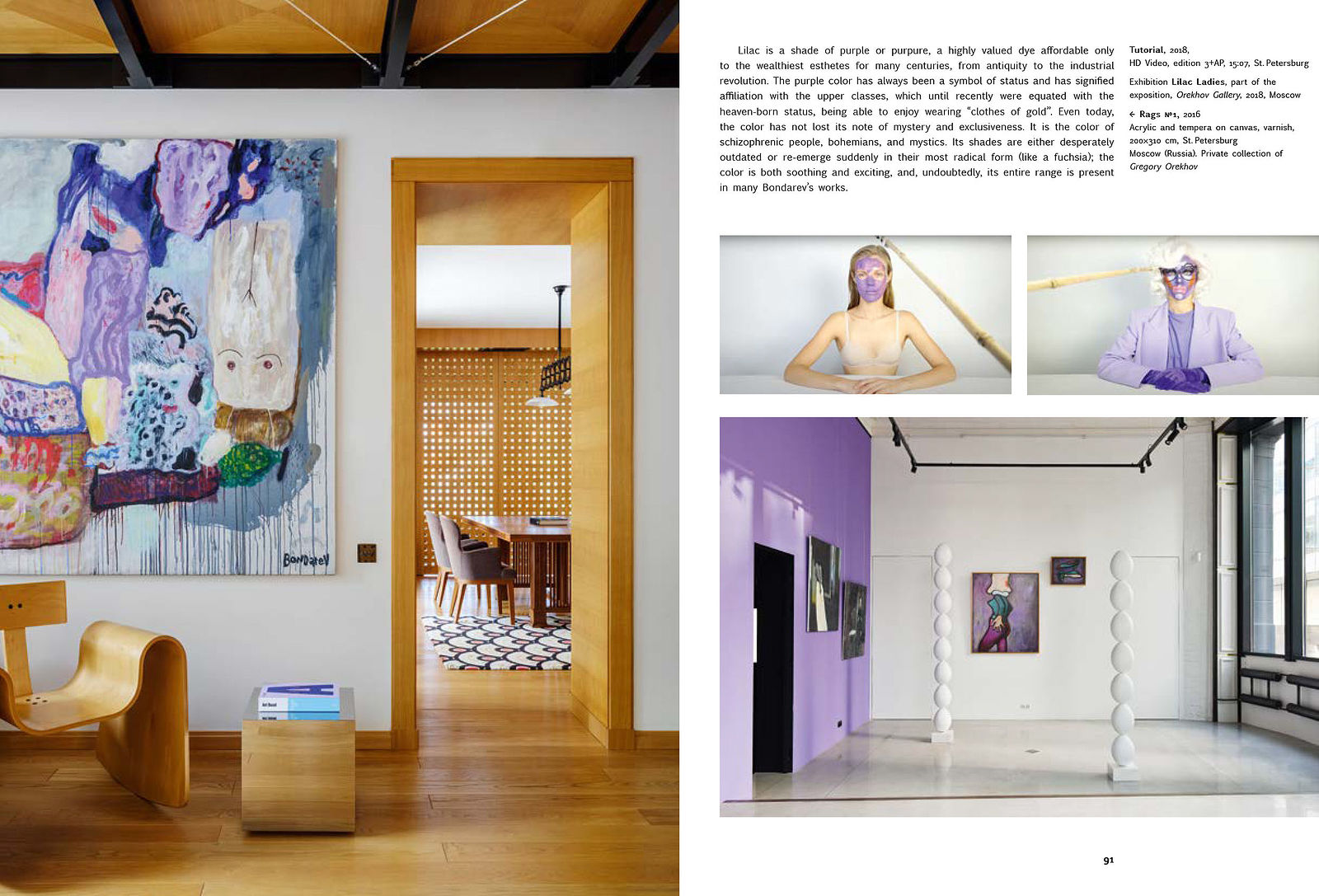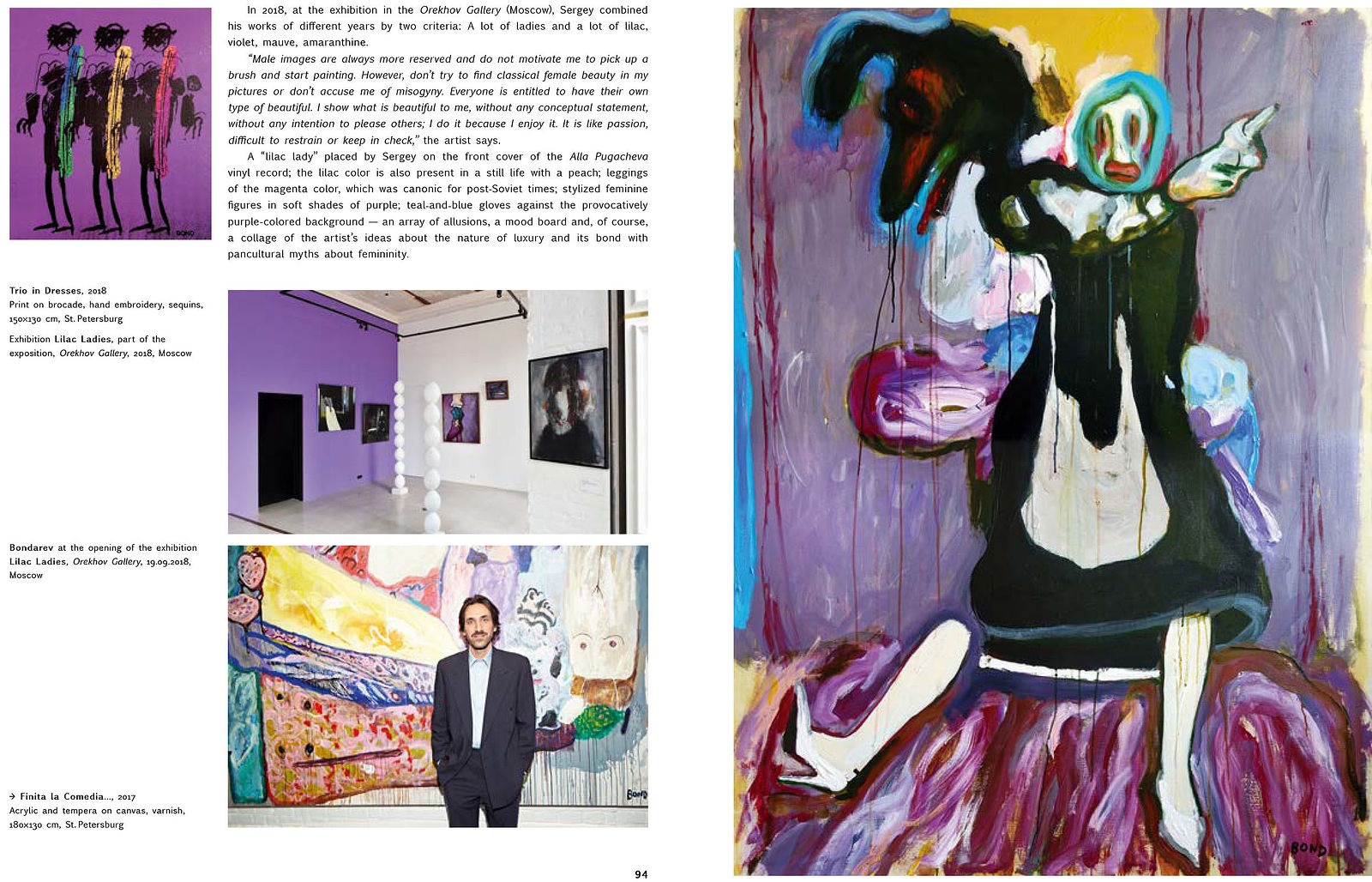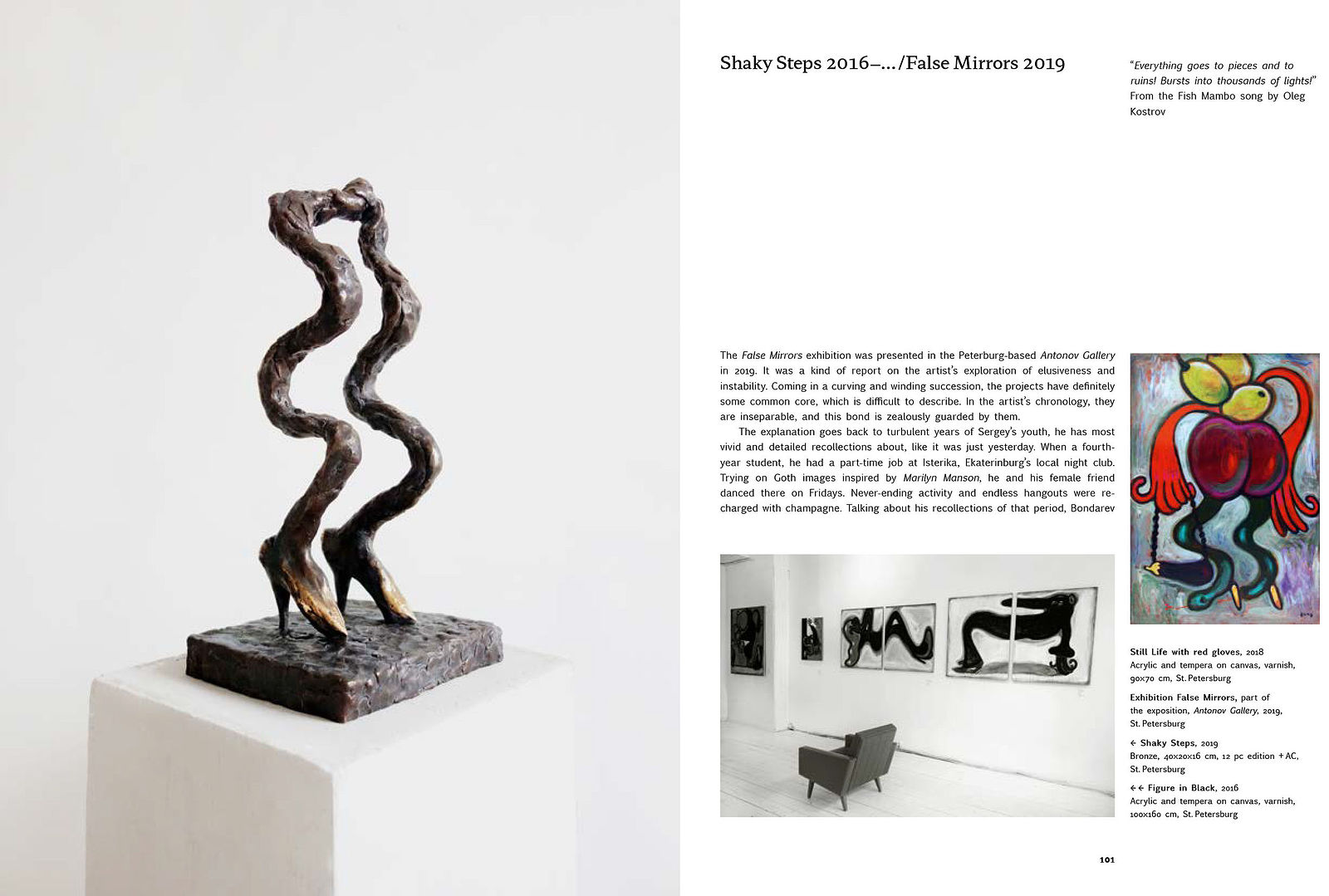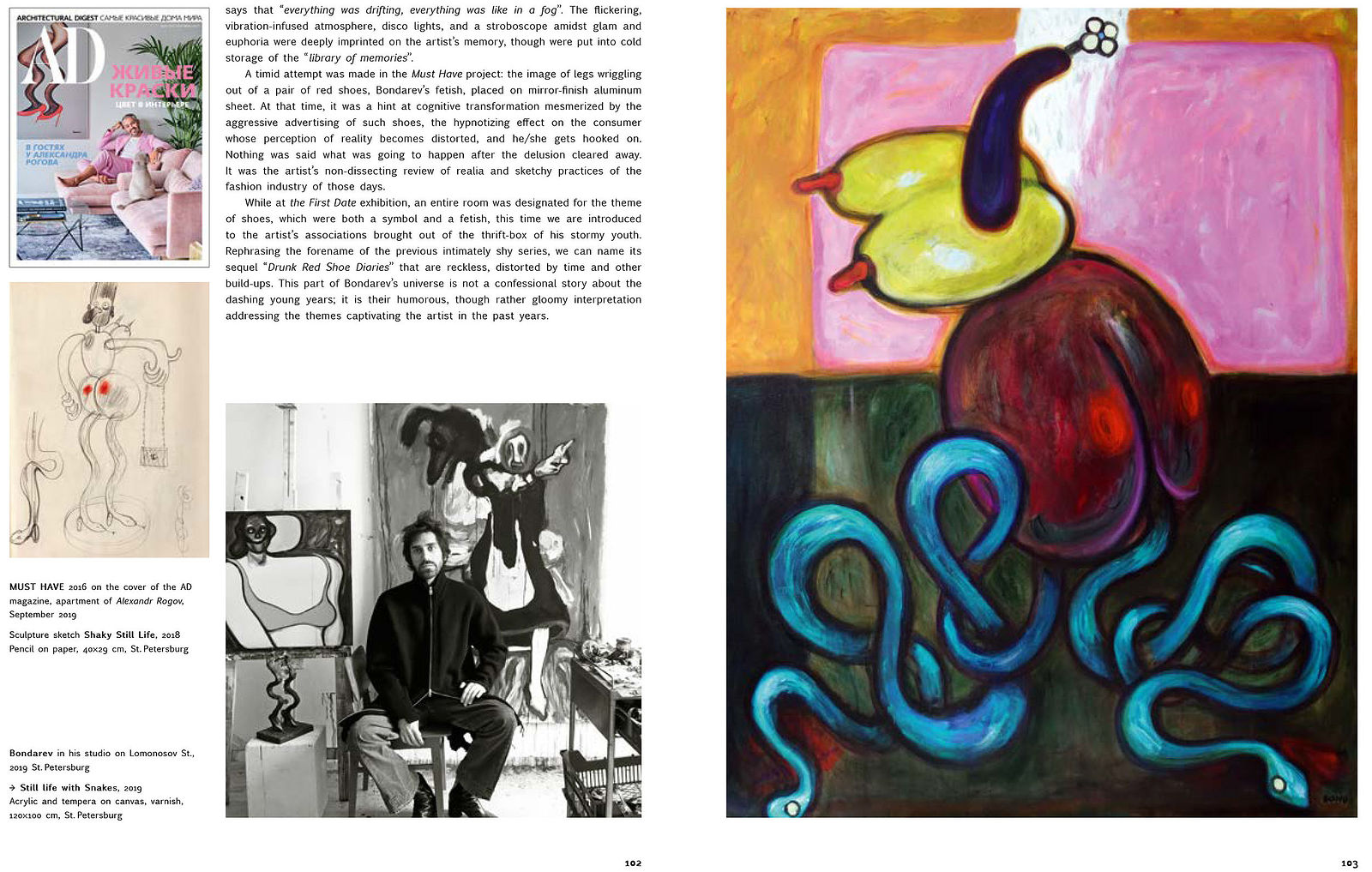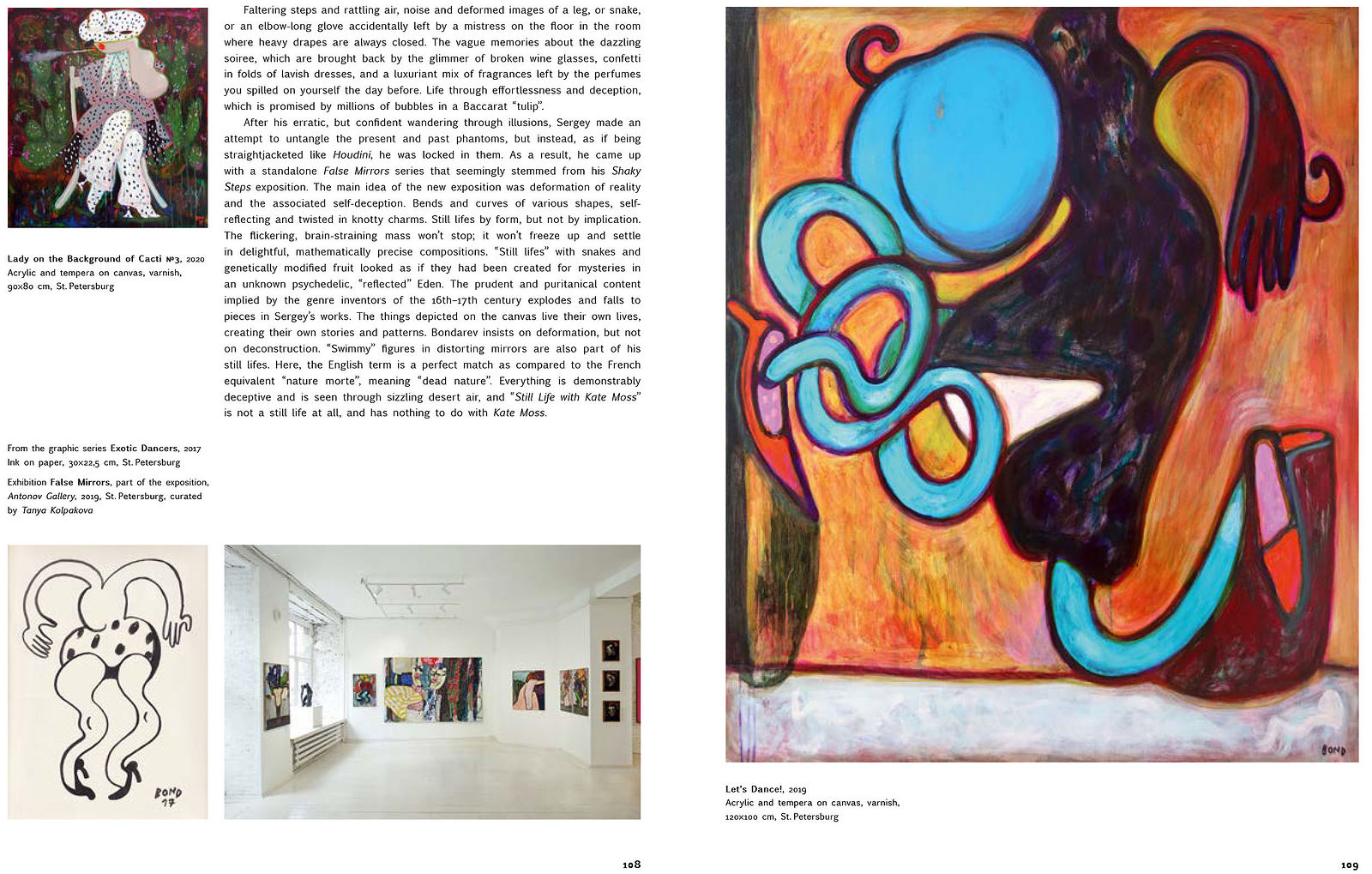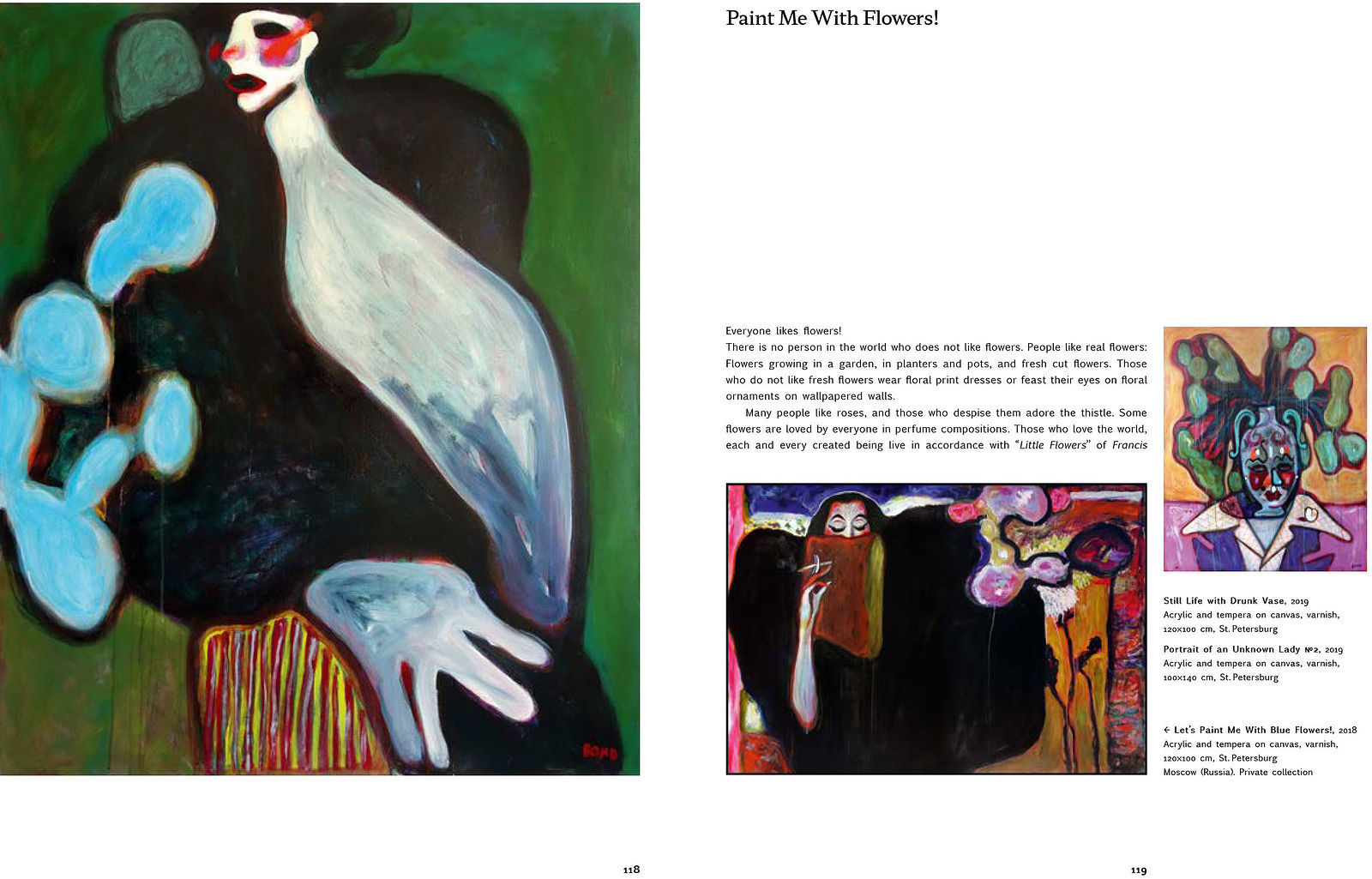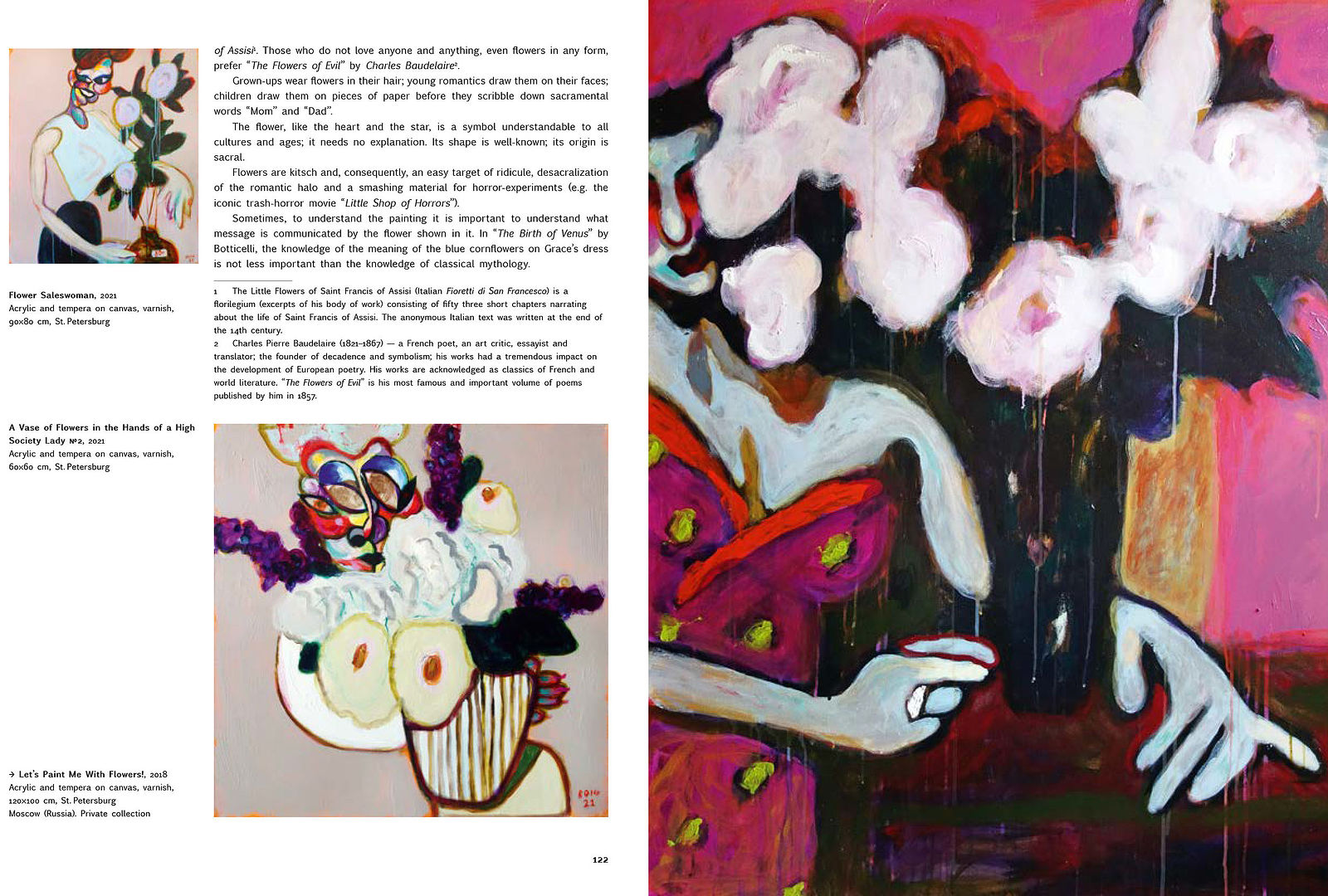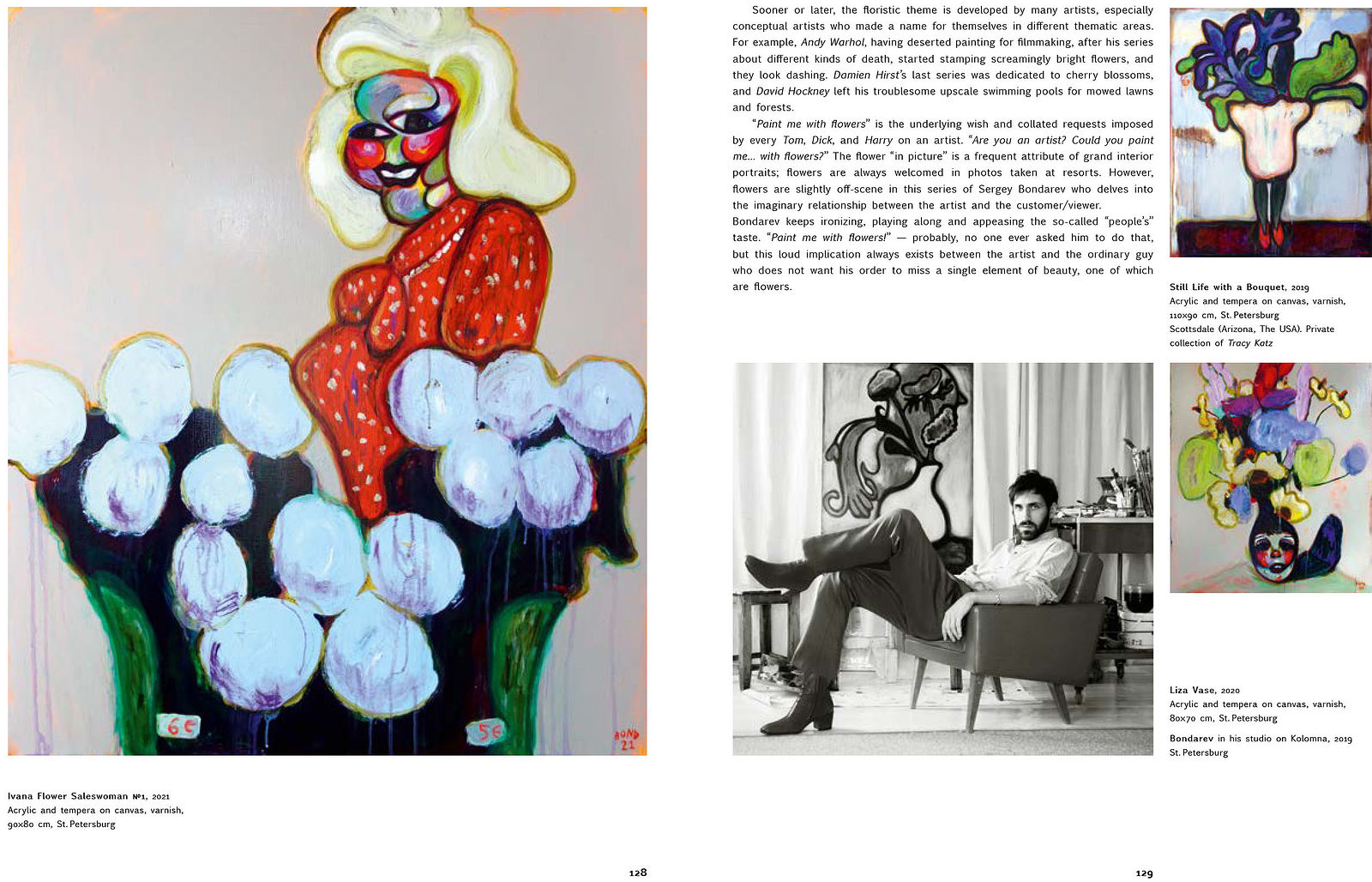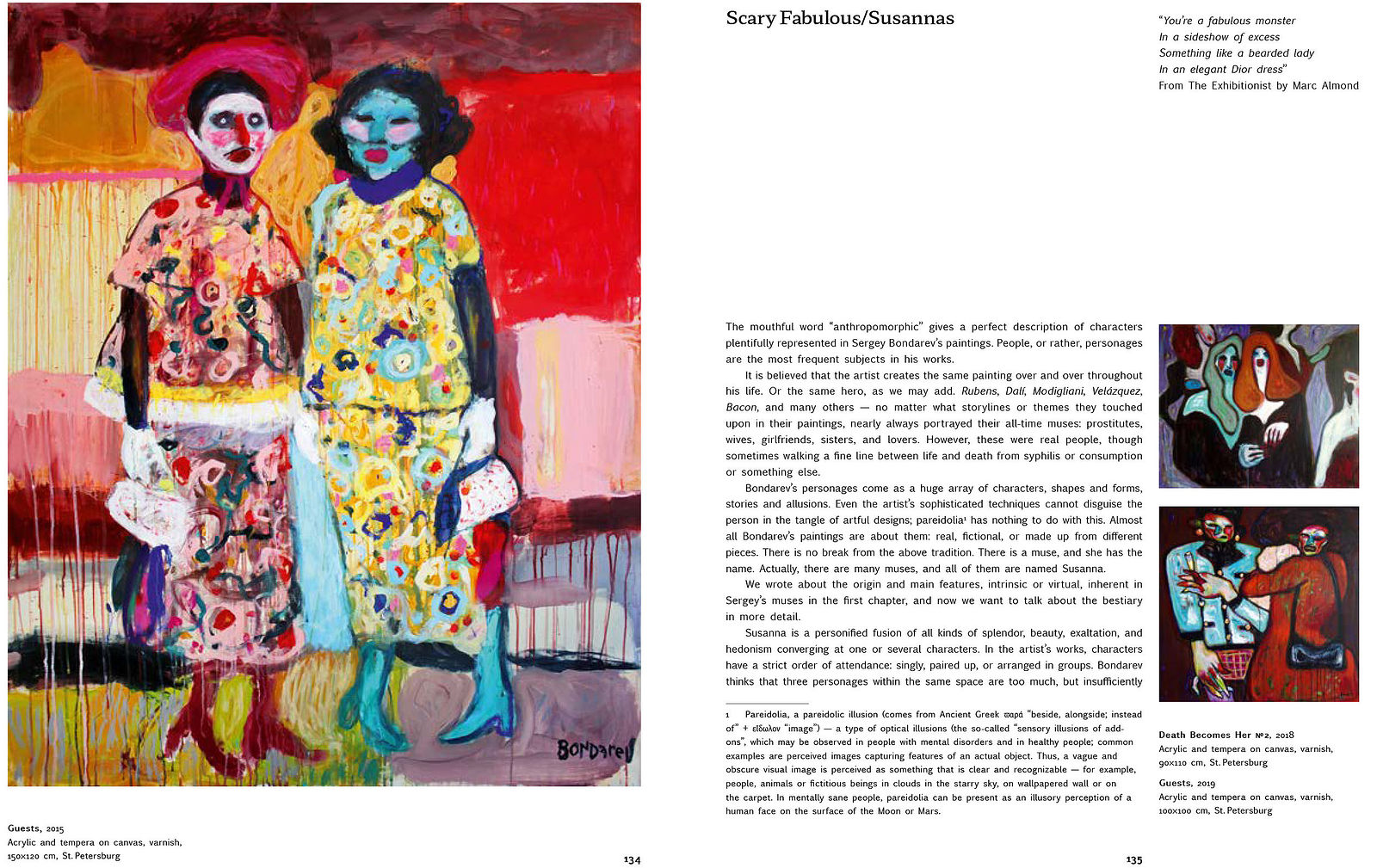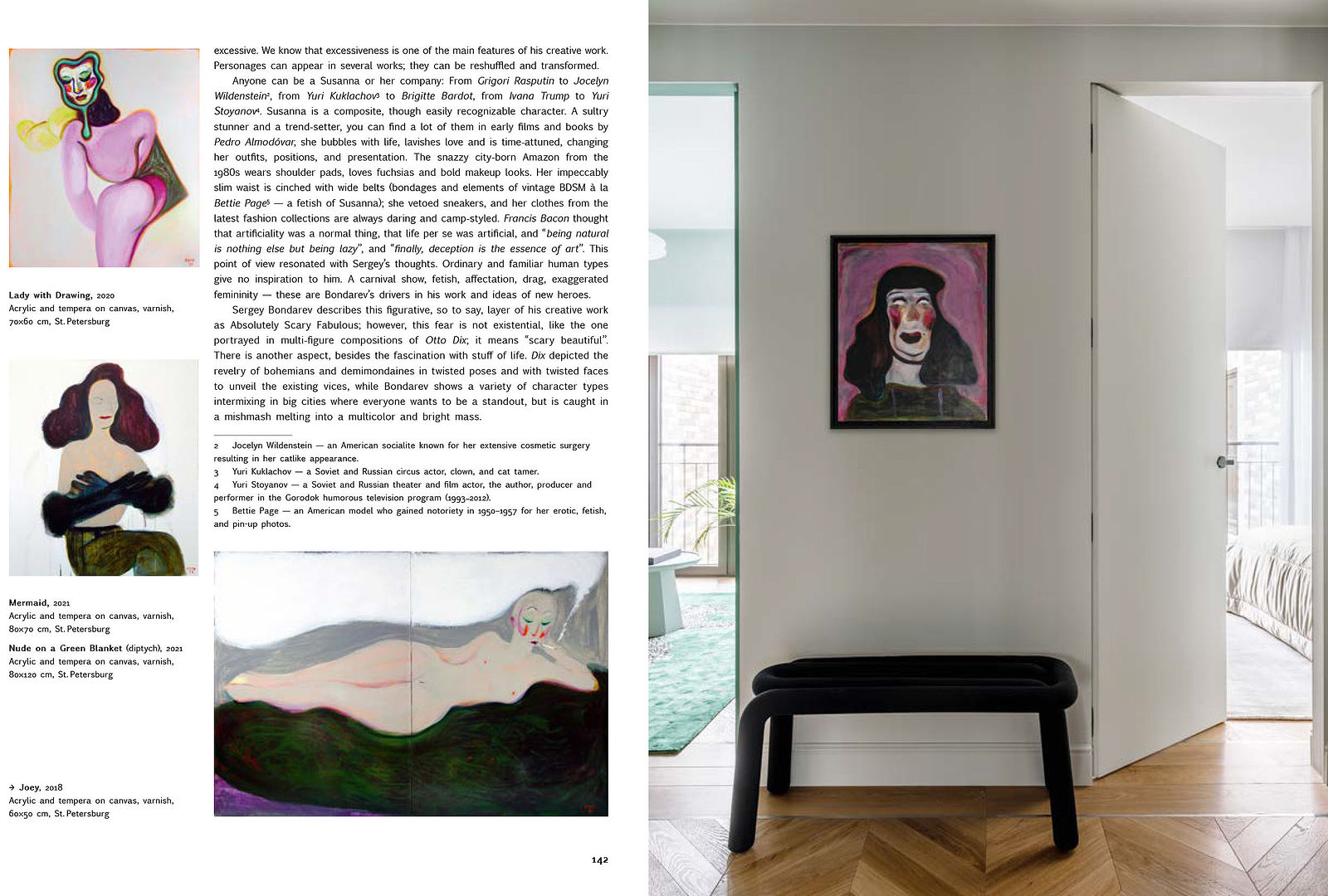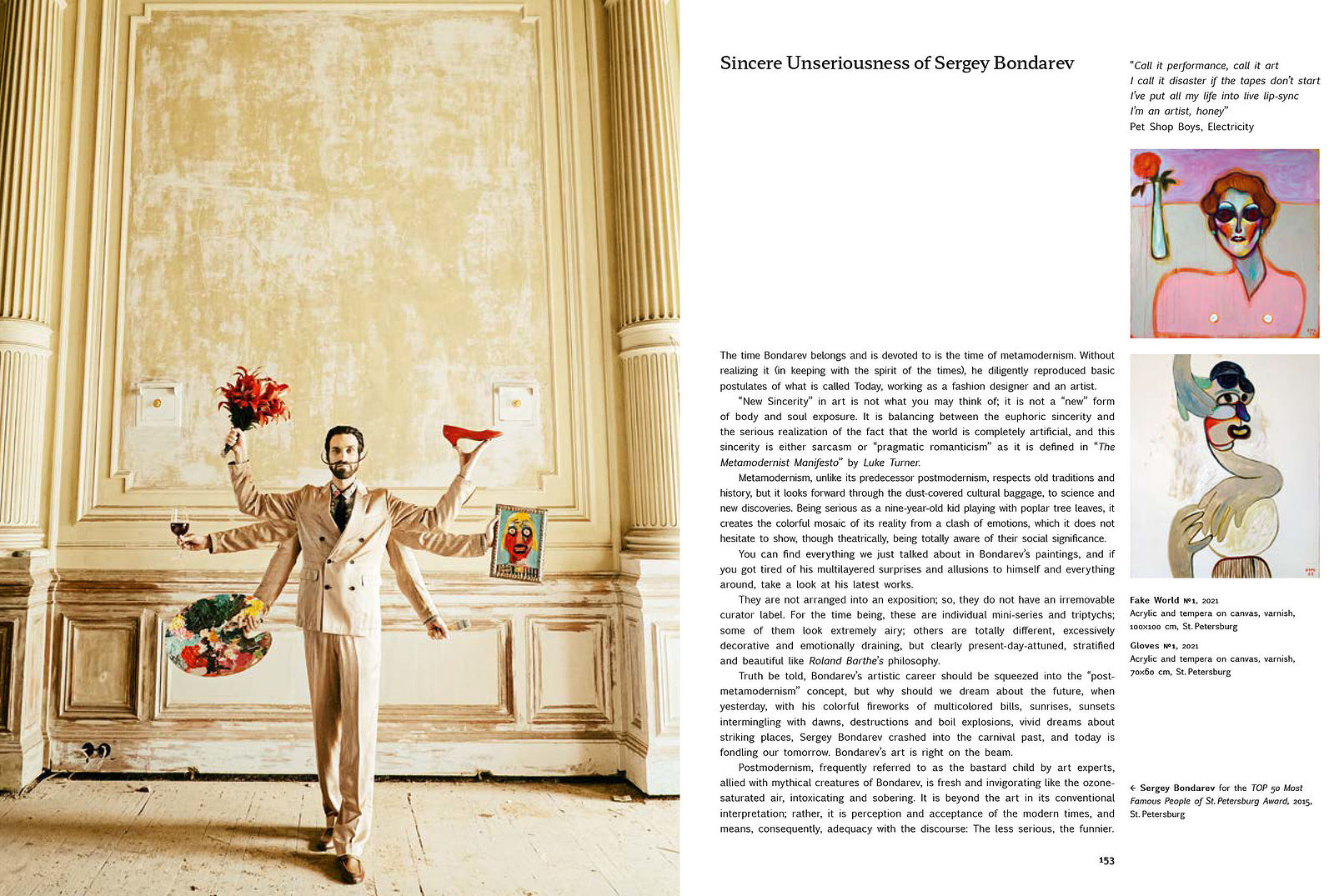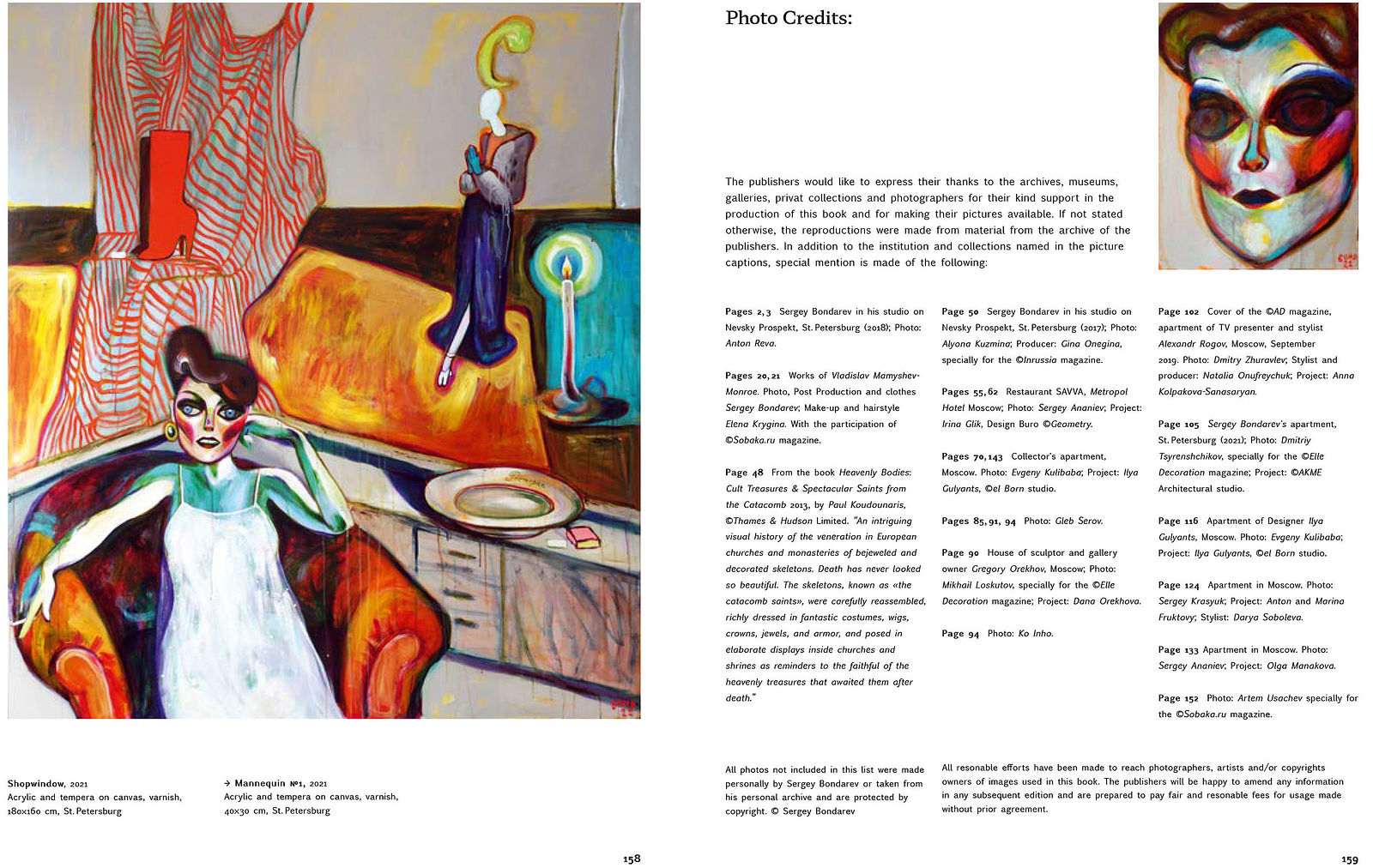REED THE BOOK ENG
SUSANNA'S ADVENTURES 2021
… Living through surreal fantasies: Strong-hand touches intermingling pale and vibrant colors drawn and vanishing in whirlpools! Constellations of whirlpools of colors are like a portrait, like a symbol, like a sign… Though should be seen as poetic verses:
Bamboo – anchor ropes!
Quo - and - intia
Thundering
Chorus of rocks
Rained by the sky…
Artist A. Bartenev / A. Kruchenykh
INTRODUCTION
There is an expression – "to overpaint something" or, in other words, "to paint the devil blacker than he really is". It refers to people who try to present the situation in a gloomy view, exaggerate the dangers or want to emphasize and unveil someone’s imperfections that other people may see as insignificant and barely noticeable. I think that’s exactly what Sergey Bondarev does when creating his works, and not only metaphorically, but also in the truest sense of the word: He overpaints, laying colors thick. Moreover, looking at his pictures, the thought that had never occurred to me came to my mind: This worn-out and overused expression came into general use from art of painting. Sergey Bondarev hardly ever uses mid-tones; he is infatuated with screaming colors, bright gaudy spots, hypertrophied and near-absurdity images, which, in their turn, are often borrowed by the artist from mass culture, which is foreign to the palette of nuances and subtleties. Yet, his approach to life does not suggest any exposure of evils inherent in modern civilization. The somber pathos of Goya and van Gogh is alien to him. The blatantly unnatural colors adored by the artist emphasize his disinterest in the actual reality and realism, conceivably cross-referring to conditional reality of paintings by masters of the World of Art. The world is full of simulacra, vulgarity, falsity, and trash, and Sergey Bondarev uses all these enthusiastically in his works, though, apparently, without any intention to uncover any immoral improprieties. On the contrary, he seems to offer the audience to follow his example and to dress in eye-catching and expressive, like his pictures, outfits to take a most active part in the action and to turn the sunk-in-vice performance society into a merry carnival.
Marusya Klimova is a Russian writer and translator. She was awarded the French Order of Arts and Letters. In 1999 and 2000, she, together with artist Timur Novikov, held Petersburg’s decadence Dark Nights festivals.
BORN, STUDIED, DANCED
His zodiac sign is Scorpio; his birth year is 1980. He was born and spent his childhood years in Sverdlovsk (the Soviet Union).
Bondarev’s earliest childhood memory is how he bumped into a built-in electric fireplace during the game. His brightest recollection of his first experience in art and fashion design is how he painted his legs with green enamel paint to mimic tights, and how he dumped the remaining paint onto the neighbors’ balconies from the upper floor of the five-story apartment building where he, a future artist, grew up. It may have been this thoughtless prank that made him aware of his future distinctive style where elements of beauty and multiple art techniques are intertwined and teamed up, emphasizing, complementing, and explaining each other.
His hometown was Sverdlovsk, an industrial city with fuming smokestacks making up the city skyline.
Failing to find common ground with his peers, having no interest in their games and amusements, he spent all his time around adults. Sergey’s parents worked at theaters. His mother was an actress at the Puppet Theater; his father was a set dressing engineer at the Drama Theater. Being a sickly child, Sergey spent with them more time than in the kindergarten.
In scene shops, costume, wig and dressing rooms where he sat quietly drawing or playing with homemade toys, he was getting one-of-a-kind education that mapped out his path. Unlike most of the children of that time, Sergey was fascinated with the idea of becoming an animated cartoon designer rather than being an astronaut.
He has been drawing for as long as he can remember; he still keeps drawings, the themes of which re-appear in his present works.
The family lived in a hostel, together with other theater workers, and, apparently, it was a proverbial melting pot mixing and merging all the elements, down to the neighborhood library. It was an invaluable source of information so needed for Sergey’s further growth; all best art albums available at that time were at his disposal: Herluf Bidstrup’s caricature cartoons, black-and-white classical art prints – photographs of famous paintings, his favorite being Cranach, a strange choice for a kid. Amid all this, his peculiar sense of humor was formed. The picture would not be full without Baltic fashion magazines of the 1970s – 1980s.
He spent his spare time either with his parents or with his grandparents who lived on the outskirts of the city, where the pine forest made a contrast with the industrial landscape. The communication with nature and the pastimes in his granddad’s carpentry workshop were a source of inspiration for the little artist. Finally, there was another grandmother who lived in Vladivostok2, which with its entirely different landscapes, hills with scarce vegetation, harbor and crabs left a deep impression on the kid. In contrast to the fictitious artistic images surrounding him in the theaters where his parents worked, his Vladivostok grandmother introduced him to different beauty – the beauty of Soviet-time salesgirls having impeccably manicured nails, wearing starched aprons, and selling braided challah bread.
As Sergey says, he was equally influenced by his fantasy world and by the humdrum reality, without which "there would be too much of a fairytale; the reality brought a little horror to my life."
Rather than television, fairy tale and pop music vinyl records, were Sergey’s best friends. Listening to them, he tried to imagine how these stories and songs performed by Alla Pugacheva, Sofia Rotaru, or Valery Leontiev would look in reality, from costumes to set designs. Later, he will come up with a series of works dedicated to paper front covers and sleeves of Soviet records.
Factory-made toys gave no joy to him: His Mom and Dad made his toys by themselves; and who knows, this habitual setting amidst hand-crafted and unparalleled toys may have also contributed to the uniqueness and singularity of his future works.
Sergey hardly remembers his elementary school years; he was not involved in the class activities (except for performances, for which he made puppets imitating the trendy style of Obraztsov); he was not interested in studies, and even now, he brushes off any memories of his secondary school years. Everything changed when he, a ten-year-old boy, was enrolled in art school where he finally felt at home; he even made attempts not to go to his regular school. As a child and a teenager, he was reclusive and unsociable, disinterested in his classmates’ pastimes. He never had conflicting feelings or doubts, being steadfast in what he was doing.
At the children’s art school, they started with children’s exercises when they illustrated fairy tales by Pushkin to move on to "adult" novels such as The Master and Margarita by Bulgakov, while getting their academic education without sacrificing their creative freedom.
Finding himself in the familiar artistic environment, our hero let his freak flag fly: Sergey tried to dress in the latest fashion, borrowing things and ideas from his dad’s stock of snazzy clothes. There were flare pants and pointed dagger collar crimplene shirts that used to be so trendy in the 1970s.
After nine years of the secondary school and four years of the children’s art school, he had no difficulty being admitted to the Department of Graphic Design at the Shadr Art College where he was the youngest student in his course. The college was known as a pillar of the "Soviet school" famous for its classical approach to education and commitment to cast-iron discipline. While exploring the entire range of subjects – from anatomy and painting technique to typefaces, Sergey and his groupmates were grasping the mysteries of the art that will be later known as designing: They hand-made and painted self-designed kefir cartons, invented non-existing brands and their logos, while learning and continuously practicing the canons of academic painting and drawing with indispensable plaster casts, sketches, nude models and plein air painting practice.
Bondarev’s slightly nervous and somewhat sketchy manner of drawing also has non-trivial roots. The students were required to remove ice from the school yard; after a couple of hours of cleanup work, they came back to the classroom to draw. Their frost-nipped fingers refused to draw "correct" lines, reproducing the Toulouse-Lautrec style instead.
The 1990s did not come as easy and untroubled time; many of Bondarev’s fellow students became drug addicts, but Sergey was not among them. His instinctively pragmatic attitude to his future self-actualization and his place in life made him seek enjoyment in other fields of art. At the age of sixteen, during his museum internship, Sergey stayed in St. Petersburg, and it was a game changer. He realized that he wanted to live and work in that city, but we will talk about this later.
The mastodon teachers provided students with a tremendous technical and cultural platform; however, none of the graduates knew how to fit into the modern and challenging realities.
At the same time, Sergey became interested in fashion and in everything that related to it. At 17, still a student, having the required physical characteristics, he decided to make some extra money by working as a model. He stroke up contacts with fashion designers – local and out-of-towners, and this communication set in his esthetic and career course for the future.
After college, Sergey faced the choice: the army or university. The solution was clear-cut: It was the Ural State Architecture and Art Academy, the Monumental Art Department. Wall panels and murals, mosaics, tapestry, frescoes, and bas-reliefs – everything that serves for decoration of building facades and interiors of public space – and all these fit into the specialization of the course. Monumental art has its nuances of portraying people and objects; this technique can be compared with the flat and static style of Ancient Egyptian murals, while having strong links with cubism and decorative ornamentation.
The time of Soviet heroic renderings of workers and scientists holding sheaves and satellite models in their sinewy hands was over. In the late 1990s, students had to create variations on secular, religious, or a little more abstract themes. For example, Bondarev was given the task to work on the design of the Japanese Culture Center in Ekaterinburg; his diploma project, by the way, was aimed at creating a panel painting in an imaginary Fashion House.
While studying at the Academy, Sergey learned to work quickly, regardless of the size of the site and the project. These skills had a significant impact on his prolificacy and on sizes of his paintings.
Being entwined with the artistic environment – the family, art school, college and first years of the Academy, Bondarev started getting tired of the omnipresent art, absence of creative freedom at schools; he lost the freshness of perception. Many things became habitual; the novelty effect was lost together with excitement from learning new techniques and methods strongly needed for implementation of ideas and reaching of targets. Everything related to art turned into everyday routine; in fact, this profession was not able to boast numerous successful examples of self-actualization and a rewarding career, at least, in Ekaterinburg. The world of local exhibitions and workers of art lacked artistry and attractiveness.
The Academy had a program for students majoring in Apparel Design, and Bondarev’s achievements in the fashion stratum helped him strike up a friendship with future fashion designers, who he still communicates with. Sergey started taking part in student projects of his new buddies not only as a model, but also as an apparel designer to chill out and to get away from the academism he was fed up with.
It was then that the image of Susanna was born – the artist’s virtual alter ego – a bold and lively girl of indeterminate age. Her cheeky, unsophisticated, vibrant and distinctive image unambiguously reminded of the Dynasty television soap opera of the 1980s.
While Sergey’s classmates were working on their course projects on monumental themes, Susanna made a show during the Ural Fashion Week in a full-fledged clothing collection, eccentric and bold. The success had such a great effect on Sergey that he seriously considered moving in a different direction. It was not about changing the course of study, but he started thinking about the synthesis of the previously received technical and academic knowledge with the esthetics and spirit that were inherently modern or, in other words, with fashion (as you can remember it was super trendy to be swanky).
Sergey’s diploma project, as we previously noted, was monumental painting design of the imaginary Fashion House. The first John Galliano haute couture collections for Christian Dior and later Thierry Mugler collections for his own House inspired Sergey almost more than his favorite Vrubel and Cézanne.
Hypertrophic and grotesque elegance of Mugler, decadent passively aggressive expression of Galliano, Yves Saint-Laurent as a role model became benchmarks in the wonderful new world that would soon open its door for the monumentalist graduate.
Being a third-year student of the Academy, Bondarev, together with his friend Anna Petukhova, started working as a dancer at the local Isterika (Hysteria) night club, and the first entry in his employment record book was a "ballet performer". He opted for a glamorous Neo-Gothic style: Something between Marilyn Manson’s and Alexander McQueen’s shows of that time. Along with his physical attractiveness, Bondarev decided to take advantage of his artistic skills. On Sundays, the club hosted drag queen shows where our soon-to-be artist was able to use all his knowledge about the history of beauty: Very few Ekaterinburg drag queens knew how to do makeup, and Sergey’s academic skills, which had been developed for more than ten years, helped the performers reap the well-deserved fame, while Bondarev gained new experience, tapping into drag culture, though in a somewhat cropped form. In his words, "the drag queen esthetics overwhelmed him."
No matter what thought can run through the mind of our prudish reader, we have to backtrack and remind about the innate detachment and purity of thought of our hero. In a dandyish manner, he slid over the surface of things, without going deep; however, their particles could not but leave an imprint on his outsoles.
While doing makeup on drag queens and spending many hours in dressing rooms, the artist by vocation could not but capture all that rampage, nuthouse mess, and bacchanalia in his memory and in photos. Backstage reports will later form the basis for themes and compositions of some of his pictures.
His last year at the Academy was approaching its end. Sergey did not relish the prospect of working in houses of newly rich elite and creating wall murals à la "here is a winter evening, summer heat, and here is Venice in spring"6, but having tremendous academic experience in art, the artist ventured to fuse it into the opening opportunities.
There were people and ideas to seek inspiration from: A magazine, which came to hand - an issue of Italian VOGUE with the monthly column by Anna Piaggi who waggishly, showing an amazing sense of time and perception of history, sketched out the sharpest and edgy ideas of masterminds of fashion.
So, Sergey became a contributor-illustrator for a local glossy magazine. At first, he, with the help of illustrations, adapted fashion trends to needs and realities of Ural fashionistas; later, he created storyboards for fashion photography, which were so ideal when benchmarked against the world ones that very soon he was entrusted and authorized with stylizing his own stories. Then he became a fashion editor, and great career prospects were ahead. The twenty-three-year-old man having tremendous cultural capital had outgrown his hometown; he was sent on a business trip to Moscow, and he went there, taking along his "fashion" and "illustration" portfolio. The trip was a lucky hit for Bondarev.
BEARDED BABY
Having worked as a freelancer with major glossy magazines for a year, at the invitation of one of the Russian brands, Sergey moved to Istanbul, where he started working as a designer at the factory making collection clothes. Istanbul was the birthplace of the Bearded Baby. Working at the factory, Bondarev delved into all the subtleties of clothing manufacturing, and in 2007, he decided to create his own brand.
Who is the Bearded Baby? At first, it was Annie Jones – a perfectly real girl with a beard; she lived in the early 20th century and was a great success, touring with Barnum’ circus as a circus attraction; despite her beard, she was absolutely happy, won hearts of a lot of people, lived a long and eventful life. It was she whose image adorned Sergey’s brand logo. The Bearded Baby symbolized the changing world of values, the world without overemphasized masculine or feminine energies; this image symbolized a strong personality and self-deprecating sense of humor.
The brand DNA was based on the signature prints, and all the collections were wired up to them, extending the Bearded Baby’s story from season to season: Bearded Girl-Woman-Grandmother-Zombie. Describing the clothing, he created those days, Sergey uses the term "conceptual", but with the focus on fun and camp rather than on contemplation and intellectuality.
Having moved to St. Petersburg, Bondarev continued his work on the brand, making presentations of his collections that looked like exhibitions or performances; he gradually moved back to his main vocation.
The drawings created for t-shirt printing were taken to canvases, and then sequin embroidery – an unusual new type of mosaic was rediscovered by Sergey to be incorporated in decorative panel pictures, which became standalone works of art, a basis for the artist’s future concepts, and his signature technique.
Sergey’s first full-featured exhibition took place as the brand’s side project with the Bearded Girl being the main character. It was a photo-project telling about the adventures and daily life of the artist’s "muse".
MUSE
The Bearded Baby as a project participated in quasi-cultural events. During one of them, in Vladivostok, Bondarev met the Muse of his life, the remote idol of his young years – Vladislav Mamyshev-Monroe whose moral support gave him an impetus and strength for self-assertiveness and confidence about the right choice of his path. The Bearded Girl awoke an echo in Monroe’s heart, and he longed to impersonate this image, together with Bondarev. Their further friendship transformed into jointly created images of Dalida and Greta Garbo in the role of Anna Karenina and homage to Monroe’s earlier project about Politburo members. A new chapter in Sergey Bondarev’s life started – now he was an independent artist.
At 1990-s, Moscow became a birthplace of such magazines as OM and Ptyuch, and their "pernicious" influence and the information they poured onto post-Soviet teenagers affected the vector of Sergey’s interests and new passions. The Internet was still not there, and these magazines were the only link with the wider world. In the Ptyuch magazine that he bought with his scholarship money, Sergey for the first time saw works of Vladislav Mamyshev-Monroe – the person he had once seen on a TV channel. Monroe’s works shook up and changed all his ideas about an artist and his or her role in the contemporary world. He was surprised to find out that an artist was not just a person standing in front of a canvas or hand-painting trays, but, re-phrasing Oscar Wilde’s statement, it was the person who turned his life into a self-existent work of art by playing with techniques, the language of expression and genres. This discovery was a shock to the young artist who grew up in the enclosed academic environment; the color wheel started spinning, confetti flew around, and the sparkling fog filled the air to the strains of songs by Organic Lady.
Vladislav Mamyshev known as Monroe (1969-2013) – a Soviet and Russian artist and actor. He is renowned for his impersonations of celebrities, pop icons and different characters, frequently during performances and at high-profile parties, during presentations of his or other artists’ exhibitions. He meticulously documented all his impersonations, creating full-scale art projects. He is the winner of the Kandinsky-2007 prize in the Media Project of the Year category. Cindy Sherman and Yasumasa Morimura work in the similar manner.
HMM… (2013)
Oh, she move like the diva do
I said, "I'd love to dance like you"
She said, "Just take off my red shoes
Put them on and your dream'll come true"
Kate Bush, The Red Shoes, 1993
Having settled in St. Petersburg, Sergey continued working on the Bearded Baby. The enjoyment, the initial sense of novelty and effortlessness turned into business that was nowhere near creative work. Yet, the vibes of the cultural capital reminded of themselves. Having moved in to a large apartment on Nevsky Prospekt, he converted one of the rooms into an art studio, which became an art-therapy retreat for him when he wanted to remove himself from stresses of the fashion routine and brand management. Having no explicit and sophisticated concept, which he, like many present-day artists, could push forward in front of his works, Bondarev relied on his impressions, emotions, observations, and perception of his own life and the surrounding world. Those days, his surrounding world was primarily made up of fashion. Eventually, his drive, dedication, and six-month work paid off. There were many (around thirty) hand-embroidered picture panels and paintings, enough for an exhibition, and the exposition was so ideal and complete that, preferring to go big, Sergey offered it to the General Staff of the Hermitage. Disappointingly, they had "all coming events scheduled for years ahead", so, eventually, the exhibition took place at the equally reputable Erarta Museum of Contemporary Art.
"Mda...", a Russian version for "hmm", an interjection expressing indiscrete feelings, perceptions, emotions, and other responses. "It is the word that I love to hear when non-artistic incompetent people see my drawings, paintings, and other exercises," Sergey says. Also, "Mda" looks like the word "moda" (Russian word for "fashion", without the letter "ąŠ"), something half-way between fashion and art, the borderline, along which he was diligently walking for the last ten years. The main idea of the works is fusion of the opposite extremes, visual demonstration of the fact that beauty can be horrible and the horrible can be beautiful.
"I have always believed that fashion is a full-fledged form of art rather than its younger sister," Sergey continues, "That explains the themes of paintings where we can see characters who go frantic consuming new arrivals, we can see people from the "Society Column", the cult of consumerism in its exaggerated, ironic, and grotesque form."
The red shoes made from firewood logs for the fireplace in Sergey’s apartment are the centerpiece of the exposition. Everything revolves around them. The legend prompted by Bondarev’s imagination says that thanks to the bombastic advertising campaigns and manufactured buzz around them, "everyone wants them!", though they look homely and unattractive, as often happens in the world of fashion. Actually, these wooden shoes "Must Have 2013" were the objects, while the painting was their "advertising campaign" and the Society Column series represented it-girls and boys who were crazy about them.
The theme of shoes was juxtaposed with images of hairy faces – a wink at the apparel brand Bondarev was still working on. However, having achieved success among art lovers and art collectors (including Western ones) and having been awarded by the Sobaka.ru magazine as The Artist of the Year, Bondarev decided to leave the fashion business, go back to his roots and plunge into art. His last clothing collections looked like works of art, and his later paintings still reflected fashion themes. The pool of themes and images accumulated over the years of "fashion games", and the newfound freedom of the artistic language, which had been strongly disapproved during his study years, gave him a boost for coming back to art after the nearly ten-year-long "art-ascetism".
FIRST DATE (2015)
Bondarev’s next exhibition, The First Date, at the Beatnik Gallery (St. Petersburg) stemmed from and continued the previous exhibition themes, expanding and extending his personal universe, bringing in new ideas and know-how of the artist. It had lost its spontaneity and escapism, having replaced them with elaboration and logical arrangement. This time, Sergey digs into the theme of his surroundings. New Impressionism – the term used by the artist to describe his new exposition: Impressions, emotional rather than visual, which he brought into the displayed art pieces.
The external, "cover" concept was simple as a girl story from the Letters Department of the COOL Girl magazine: The initial meeting, the bouquet-pink stage, the intimacy-pastel stage and dreams about beautiful, sexually rich life. This unsophisticated storyline was mirrored by the logic of the exposition.
The entrance group was dominated by "The First Date", a sequin-embroidered portrait of a happy girl wearing heavy makeup; there was a vase with flowers under the portrait, and the whole composition was intended to symbolize the first date and butterflies in the stomach. This is the time when people in love think idealistically, most of their doings lack logic; this type of behavior was captured in "Rich Fantasies" next to the bouquet: rosy dreams about the fairytale life the sweethearts were going to have.
The next part was about the "candy-bouquet" period in their relationship: The entire wall was painted in different shades of pink color, showcasing abstract-clownish compositions created in the same pink color. In the center of the room, there was a raised platform with wooden items (heads of "victims of failed dates" and a talisman – the familiar red shoes).
Then there was a "bed": photo wallpaper murals displaying works of the photographer Vadim Kovriga, picturing mattresses found at Parisian junkyards; they were borrowed from his Entrailles series perfectly fitted in the context of Bondarev’s universe. This print served as the background for three works, one of which, "Moment # 2", became the linchpin for the further creative work and the DNA of the signature style of the artist. The print shows a "random" photograph of a table and slightly disarranged table setting snapped by Sergey at some point of his life. Its composition is reminiscent of still lifes by Pyotr Konchalovsky and polaroid pictures by Warhol looking for an ideal composition. Reflecting on the theme of his new life in St. Petersburg where the splendor of nouveau richeism contrasted strongly with the misery of the older aristocratic culture, Bondarev wanted, giving no criticism, to merge these two opposites, and with the meticulousness of a natural philosopher, he set out in search of the philosophers’ stone, which epitomized the natural symbiosis of these extremes. He describes it as "a confrontation between trash and hyper-beauty", a borderline game where each person makes their own choice, deciding whether these are glass fakes or gemstones.
Guided by his contemplations, he, following the visionary expression of Malevich, daringly fills the entire space of the canvas with paraphernalia and gold sequin embroidery. The outcome is striking: The trivial storylines (and then – things and characters), wrapped in glitter, acquire radically different value and status; still being what they are – wacky, goofy, and still unremarkable – they transform to become precious, rising above the bustle of everyday life.
The last room showcasing the wall with a photo wallpaper mural, which pictured another mattress, more "wrecked" and somewhat giving a hint at raging passion, was named "Red Shoe Diaries". The backroom setting brought the audience to the grand finale of "The First Date" story where the theme of red shoes had a full-blown and unexpected spin-off.
POETKA (2016)
An ironic tale about contemporary society, its aspirations, images that dominate the minds of its members; it is a tale about consumerist society, globalization, gloss, where, quoting the artist, "things live their own lives, and the world is ruled by chaos".
Two projects that we combined in this chapter represent a prolific and standalone stratum in the creative world of artist Bondarev. It is a triumph and glorification of commonplaceness, worshipping and bringing it from the plane of "mundane" to heavenly chambers of splendor. The religious analogy is highly well-fitting here: The names and the concept of Sergey’s works presented in this and the following exhibitions were intentionally interspersed with connotations based on play on theological words and their meanings. "Rising of a Chicken Leg", "The Creation of the Universe", collages made up from the inexhaustible stock of photographs, images and pictures of pop-culture icons.
The Kreutz Gallery showcased a series of hand-embroidered panel pictures where the images from the stock photography – hackneyed, overused and, in fact, being of no art value – rise above the commonplaceness to acquire sacral, valuable content. The series includes such works as "A Waitress", "A Man with a Bouquet", "A Woman at the Computer", "A Girl in the Supermarket", "A Female Doctor", and others, altogether 12 works. It was titanic work of a lot of people; each sequin is sewn on by hand, and it took around 200 hours to embroider each picture.
The technique of sequin embroidery on photoprints, which made its debut in the previous show, this time is blown up to the point of absurdity; Bondarev goes away from his own, capturing routine moments, and random photographs, using foolish, characterless and unremarkable images from stock photos. Poetka is a lingering and enthralling story about poetization and sequinization of everything around. Bondarev believes that everything around us is worthy of admiration, especially, the phenomena that are inherently trivial and insignificant from the prospective of highbrow and "high" culture: "People have been using sequin embroidery as a decorative or sacral technique for more than four hundred thousand years. Initially, the glitter of sequins imitated the shimmer of gold, silver and gemstones in church attire and, later, in the attire of the royalty and their household. In the 20th century, glittering sequins migrated across the border lights from theatrical costumes and socialites’ evening gowns to casual clothes. The Poetka exhibition completes the circle of history and brings sequins back to the sacral zone: The least significant moments of life become infinitely important and eternal".
The works were inspired by the words of Marusya Klimova, the artist favorite writer: "The most important thing today is a good mood!" Schematic emotions, faces and themes, which are usually used by advertisers and designers for renderings and presentations, are turned by Bondarev into a cult subject and object, and are placed into "icon covers" embroidered with signature golden sequins. Instead of a line of pictures lost in the array of stocks of photos, we have a gallery of powerful images and strong emotions, a feast for the eyes and food for thought.
MUST HAVE (2016)
Must-Have is not a twin sister or one of the parts of the Poetka exhibition; rather, it is a warm-up before this exhibition, its prequel, a rehearsal of the grand ceremony of elevation of routine, "simple" joys. It was a collaborative project with the Au Pont Rouge department store, and it included both a solo exhibition and window displays as part of the exposition in the department store. These two projects were different in the perception of almost the same works that were presented in different settings: By contrast with the dark, decadent, and shimmering loft in the Kreutz Gallery hosting the ecstatically thrilling Poetka, Must Have was presented in the merciless light of the sterile shopping space of the newly renovated Au Pont Rouge. The enchantment of the space and its intended purpose impacted the spirit of the exhibition.
Must Have is an amusement exhibition; it sparkled and twinkled, being coquettish and sarcastic, playing smart and laughing at itself and the consumption-focused ambiance surrounding it. The theme of possession, fetishism and consumerism has been developed in different projects of the artist. In his first exhibition, he was able to start a trend with heeled wooden logs, the sardonic Must Have 2013. This time, the name became imperative; Bondarev, with a peculiar sense of humor, prescribes what you must have, what and who you need to be.
The total installation included sequin-embroidered picture panels, graphics printed on aluminum (the Must Be series), collages, furniture with signature prints (Limits of Joy), and golden rails with a golden "capsule wardrobe collection".
COLLAGES
The afterimage is a type of optical illusion involving aftereffects resulting from eye adaptation to a visual stimulus.
The collage as an art technique and as a concept represents one of the key pillars for understanding of Sergey Bondarev’s art. Back in his years at the art school, he took an interest in making up pictures from isolated elements. He developed his technique and brought it to perfection, when he worked as a magazine illustrator.
Experimenting with collage tools and capabilities, Sergey stopped using scissors and glue, creating collage compositions in Photoshop, as it was faster and easier. Then, he printed them in vintage magazines and hand-painted them. Later, Sergey used his own collages as sketches for composite works of art. Using of collages made up from photos as sketches for paintings is Bondarev’s know-how, his signature approach. He creates his collages from photographs that he took himself, online pictures, screenshots of his favorite movies, which he stores up and keeps in document cases till the time they are ready for clipping, cutting and being glued to paper to be further brought to a canvas and be turned into a work of art.
Such titles as "Embroidery is in Fashion" and other similar ones in glossy magazines, which he used as a basis for his sketches, made Bondarev think that all these correlated perfectly well with what he was doing. On-canvas sequin embroidery and his "fashion" history linked up the seemingly unserious hobby of his younger years with the serious and professional present art-years of Bondarev. It is not surprising that with his monumentalist education and gift for turning routine into art, at some point of time, Sergey arrived at the idea of upsizing collages and presenting them as independent works.
Canvas-printed and hand-painted collages made their debut at the "Hmm…" exhibition and later on were further developed in different forms and materials. For example, in the "Must Have" project, the photo of Sergey’s rosy-cheeked and laughing lady-friend spearheaded the Limits of Joy series; it was printed on the pages of old fashion magazines, on fabric, and on aluminum plates.
A clash of images, references, styles, meanings and art techniques – Bondarev’s signature style catches the audience and becomes ingrained in their memory. He talks about unserious things by operating conceptual ideas of great expressionists; important things are presented in bright colors and, at a first glance, in a rather dabbling manner. Beware: You can easily slip down to the entertaining name-dropping game, an intellectual "guessing game", when each element in Bondarev’s works has some reference to something, is associated with something and hints at something. Talking about his collages, instead of associations with pioneers El Lissitzky, Rodchenko, Picasso, or Braque, who used a new revolutionary technique to rhapsodize about the new world and bright future of the planet, Bondarev’s works evoke memories of Rauschenberg4, Hamilton5, and Rosenquist6, who reinterpreted pop art by adding depth and humor.
It is interesting to watch the growth of the artist through the prism of his childhood experiences. In 1967, psychologist Ulric Neisser coined the term "iconic memory". This fancy word combination is used to signify visual memory or image memory. It is a short-term phenomenon, though if we assume that artists in general are able to "archive" and use any visual clues to produce something totally new, we can say assuredly that Bondarev was very good at that. Having unlocked the potential of the collage, he moved on to shuffling, mixing, and twisting "iconic", historic, and stylistic references he had been feeding on during his fledging years, and to creating another dimension of his universe.
CHATEAU PERDU (2018)
"There is no such thing as pessimistic art. Art affirms."
Friedrich Nietzsche
"Respice post te! Hominem te memento!"
Tertullian
Dark back streets and blind alleys, passions, vices, and a tight grasp of rules; lost, though unforgotten details that used to give a thrill, tempting and soaking up the light. Vibrant and dazzling aftertaste following the death and the opposing gloominess of life as the vale of tears. The impeccable elegance and the perfection of artificiality as opposed to the chaos of the natural order of things.
Bondarev toys with the apparent and shallow feelings of the audience, makes fun of trifling faults and naivety of present-day phenomena to move on to the "eternal": Death and its perception from the perspective of the Renaissance; he carries his universe over to the relationship between the afterworld and a European of the 16th century.
"Château Perdu" translated literally means "a lost castle"; it is a gloomy, though a cozy story, like short stories by Edgar Allan Poe, and a new layer of Bondarev’s "cake". It is not a sponge crust, not whipped cream, or chocolate buttercream. It is sticky and stringy like licorice milk jam, if only it existed; it is not to every taste, but it catches the eye of the audience, and, speaking metaphorically, keeps their eyes glued fast and tight, once they let their guard down.
When still-life painting was at its onset in the 16th – 17th centuries, artists added religious symbols to their paintings. At that time, enlightened people had their own perception of brevity of life: little-studied diseases, unlooked-for epidemics, an unexpected stab in the back by a neighbor; therefore, a skull stops symbolizing death in its physical form and takes a romantic meaning. The new system of symbols was named Vanitas, from the Latin vanitas "emptiness, futility". The skull migrated to still lifes from portraits where it served as a reminder of brevity of human life and the danger of phantom power and fame. Although it was the skull that pointed to the presence of the Vanitas Code in a painting, it disappears from the later works of art: It is assumed that the viewer is aware of the art symbols.
The skull is archetypical both as a form and an object; having once entered the top multiple-meaning art symbols, it remained there forever. For centuries, it had been an untouched sacred monster of fine art and only in the 20th century, the century of Post-Modernism, this symbol became "pop-culturized" and was re-conceptualized.
In the mid-1970s, Andy Warhol moved it from the symbol of pirates and numerous marginal protest groups to the plane of unseriousness. The skull went through the most fundamental transformation in the 1980s when Jean-Michel Basquiat made it, together with a signature crown, a permanent element in his works. Among the most famous standalone skulls-artworks are the real human skull that Gabriel Orozco (1997) covered with a harlequin diamond-shaped pattern, the giant skull made from kitchen utensils by Subodh Gupta (2006), and the diamond-encrusted skull by Damien Hirst (2007).
As for Sergey Bondarev, he received his inspiration from the Heavenly Bodies book: Cult Treasures & Spectacular Saints from the Catacomb2, which gives a detailed description and illustrations of the unusual Catholic cult when skeletons, presumably, of early Christians were unearthed from Roman catacombs to be further adorned with jewels and dressed in rich clothes.
Similar "relics", but in Bondarev couture art works, were present at the exhibition as standalone objects.
Bondarev’s new series features a lot of skulls and agonized, distorted faces from Munch’s paintings, though now they were given a kick of paint and adorned, being turned into masks. We can see a gallery of "exquisite dead bodies", both beautiful and spine-chilling.
The theme of the lost castle, the ambiance of its surroundings and the characters, who could have been its dwellers and who were "found" just now, was further developed in the Quasi-Quotation series. The mood message and techniques remained the same; however, this time, the emphasis was placed on intentional quoting and re-interpretation of classical art, with which the artist has a personal, long-playing and long-lasting relationship.
Back in his childhood, when he looked through Soviet albums about art, he was fascinated by works of Lucas Cranach. At the age of 18, when he came to the Hermitage and saw his favorite pictures, he experienced insight and, probably, one of the symptoms of Stendhal syndrome. "During my first time in the Hermitage, I looked intently at "The Virgin and Child under an Apple Tree" [Cranach], the reproduction of which I used to look at as a kid, and I wondered why it was so small and black. My own reproduction was almost the same size and much brighter; actually, every bit as good, and I felt like the owner of the masterpiece," Sergey recalls.
The theme of the lost castle, the ambiance of its surroundings and the characters, who could have been its dwellers and who were "found" just now, was further developed in the Quasi-Quotation series. The mood message and techniques remained the same; however, this time, the emphasis was placed on intentional quoting and re-interpretation of classical art, with which the artist has a personal, long-playing and long-lasting relationship.
Back in his childhood, when he looked through Soviet albums about art, he was fascinated by works of Lucas Cranach. At the age of 18, when he came to the Hermitage and saw his favorite pictures, he experienced insight and, probably, one of the symptoms of Stendhal syndrome. "During my first time in the Hermitage, I looked intently at "The Virgin and Child under an Apple Tree" [Cranach], the reproduction of which I used to look at as a kid, and I wondered why it was so small and black. My own reproduction was almost the same size and much brighter; actually, every bit as good, and I felt like the owner of the masterpiece," Sergey recalls.
Bondarev incorporates the feeling of "possession", though through cultural capital, into homages to the most pretentious classical works of art: "Judith with the Head of Holofernes" and "Ecstasy of Saint Teresa". During the same time, Cranach’s "The Fountain of Youth" was interpreted into a series of similar works showing a Baroque fountain, but that time featuring feathers. "Plumes" are the pinnacle of solemnity, and they gushed festively out of the somber and philosophical Dutch classical painting, sprinkled the artist’s previous "ghostly" period, its lavender cobwebs and precious skeletons with droplets of eternal youth.
Toying with the heritage, Bondarev delves deep into the third millennium BC. Why can the lost castle not have such artifacts as Sumerian sculptures? The marble head of a woman (Iraq Museum, Baghdad), which was found in Uruk, is the most outstanding sculpture work of the Sumerian culture. With the flat back of the head, it had been attached to the wall of a temple, being part of a high-relief composition. The goddess’ huge wide-open eyes and arched monobrow (the eyes and brows were inlaid) are very expressive. The goddess originally had a gold headdress. She became a source of inspiration for the "Sumerian Evenings" series; the artist places the Goddess into a contemporary, stylish setting where she has quite a good time, enjoying a cigarette and a glass of whiskey, and trying on the familiar, iconic red pumps.
In Alexander Blok’s poem "The Stranger", an ode to humdrumness, to ugly and reprehensible aspects of life (it tells about a prostitute), there is a line, possibly, one of the most decadent lines of all the Russian poetry of the Silver Age – "wrapped in mists and secret fragrances", which describes the effect produced by the sight of an unknown woman in a suburban café. Bondarev’s stranger hides behind an African mask, a chador or a piece of transparent cloth. This may be a fancy-dress ball or prophecy of the global pandemic 2020, who knows.
Another decadent lady character – Shannon McFarland from "Invisible Monsters" by Chuck Palahniuk – is trying on endless gauze and organza veils. Mists and veils, plumes and panda eyes, a precious skeleton nearby in the boudoir, semi-consciousness and the skin looking like the lips of dead Laura Palmer – all this mirrors Bondarev’s new thoughts and explorations in the realm of emotional decadence.
In Alexander Blok’s poem "The Stranger", an ode to humdrumness, to ugly and reprehensible aspects of life (it tells about a prostitute), there is a line, possibly, one of the most decadent lines of all the Russian poetry of the Silver Age – "wrapped in mists and secret fragrances", which describes the effect produced by the sight of an unknown woman in a suburban café. Bondarev’s stranger hides behind an African mask, a chador or a piece of transparent cloth. This may be a fancy-dress ball or prophecy of the global pandemic 2020, who knows.
Another decadent lady character – Shannon McFarland from "Invisible Monsters" by Chuck Palahniuk – is trying on endless gauze and organza veils. Mists and veils, plumes and panda eyes, a precious skeleton nearby in the boudoir, semi-consciousness and the skin looking like the lips of dead Laura Palmer – all this mirrors Bondarev’s new thoughts and explorations in the realm of emotional decadence.
LILAC LADIES (2018)
Ladies as a concept, elusiveness, a symbolic representation of something that exists, but is not tangible, are frequent heroes of Bondarev’s works. Precious things of creation, only indirectly related to our reality. The lady as a beau ideal, a playful thought existing at the associative level, the epitome of unconditional femininity. In our far-from-being-perfect world, they are represented by drag queens, silent movie actresses, and female singers endowed with special emotional faculties. Childhood cultural values imprinted in Sergey’s memory entailed such femininity. The theatrical settings, Alla Pugacheva, "the woman who sings", saleswomen from Vladivostok with their inordinate obsession with beautiful, and drag show queens were associated by the young artist with the image of an unreal (in every sense) beauty, the dream of poets and the muse of refined devotees of Venuses wrapped up in furs.
Lilac is a shade of purple or purpure, a highly valued dye affordable only to the wealthiest esthetes for many centuries, from antiquity to the industrial revolution. The purple color has always been a symbol of status and has signified affiliation with the upper classes, which until recently were equated with the heaven-born status, being able to enjoy wearing "clothes of gold". Even today, the color has not lost its note of mystery and exclusiveness. It is the color of schizophrenic people, bohemians, and mystics. Its shades are either desperately outdated or re-emerge suddenly in their most radical form (like a fuchsia); the color is both soothing and exciting, and, undoubtedly, its entire range is present in many Bondarev’s works.
In 2018, at the exhibition in the Orekhov Gallery (Moscow), Sergey combined his works of different years by two criteria: A lot of ladies and a lot of lilac, violet, mauve, amaranthine.
"Male images are always more reserved and do not motivate me to pick up a brush and start painting. However, don’t try to find classical female beauty in my pictures or don’t accuse me of misogyny. Everyone is entitled to have their own type of beautiful. I show what is beautiful to me, without any conceptual statement, without any intention to please others; I do it because I enjoy it. It is like passion, difficult to restrain or keep in check," the artist says.
A "lilac lady" placed by Sergey on the front cover of the Alla Pugacheva vinyl record; the lilac color is also present in a still life with a peach; leggings of the magenta color, which was canonic for post-Soviet times; stylized feminine figures in soft shades of purple; teal-and-blue gloves against the provocatively purple-colored background – an array of allusions, a mood board and, of course, a collage of the artist’s ideas about the nature of luxury and its bond with pancultural myths about femininity.
SHAKY STEPS (2016-…)/FALSE MIRRORS (2019)
"Everything goes to pieces and to ruins! Bursts into thousands of lights!"
From the Fish Mambo song by Oleg Kostrov
The False Mirrors exhibition was presented in the Peterburg-based Antonov Gallery in 2019. It was a kind of report on the artist’s exploration of elusiveness and instability. Coming in a curving and winding succession, the projects have definitely some common core, which is difficult to describe. In the artist’s chronology, they are inseparable, and this bond is zealously guarded by them.
The explanation goes back to turbulent years of Sergey’s youth, he has most vivid and detailed recollections about, like it was just yesterday. When a fourth-year student, he had a part-time job at Isterika, Ekaterinburg’s local night club. Trying on Goth images inspired by Marilyn Manson, he and his female friend danced there on Fridays. Never-ending activity and endless hangouts were re-charged with champagne. Talking about his recollections of that period, Bondarev says that "everything was drifting, everything was like in a fog". The flickering, vibration-infused atmosphere, disco lights, and a stroboscope amidst glam and euphoria were deeply imprinted on the artist’s memory, though were put into cold storage of the "library of memories".
A timid attempt was made in the Must Have project: the image of legs wriggling out of a pair of red shoes, Bondarev’s fetish, placed on mirror-finish aluminum sheet. At that time, it was a hint at cognitive transformation mesmerized by the aggressive advertising of such shoes, the hypnotizing effect on the consumer whose perception of reality becomes distorted, and he/she gets hooked on. Nothing was said what was going to happen after the delusion cleared away. It was the artist’s non-dissecting review of realia and sketchy practices of the fashion industry of those days.
While at the First Date exhibition, an entire room was designated for the theme of shoes, which were both a symbol and a fetish, this time we are introduced to the artist’s associations brought out of the thrift-box of his stormy youth. Rephrasing the forename of the previous intimately shy series, we can name its sequel "Drunk Red Shoe Diaries" that are reckless, distorted by time and other build-ups. This part of Bondarev’s universe is not a confessional story about the dashing young years; it is their humorous, though rather gloomy interpretation addressing the themes captivating the artist in the past years.
Faltering steps and rattling air, noise and deformed images of a leg, or snake, or an elbow-long glove accidentally left by a mistress on the floor in the room where heavy drapes are always closed. The vague memories about the dazzling soiree, which are brought back by the glimmer of broken wine glasses, confetti in folds of lavish dresses, and a luxuriant mix of fragrances left by the perfumes you spilled on yourself the day before. Life through effortlessness and deception, which is promised by millions of bubbles in a Baccarat "tulip".
After his erratic, but confident wandering through illusions, Sergey made an attempt to untangle the present and past phantoms, but instead, as if being straightjacketed like Houdini, he was locked in them. As a result, he came up with a standalone False Mirrors series that seemingly stemmed from his Shaky Steps exposition. The main idea of the new exposition was deformation of reality and the associated self-deception. Bends and curves of various shapes, self-reflecting and twisted in knotty charms. Still lifes by form, but not by implication. The flickering, brain-straining mass won’t stop; it won’t freeze up and settle in delightful, mathematically precise compositions. "Still lifes" with snakes and genetically modified fruit looked as if they had been created for mysteries in an unknown psychedelic, "reflected" Eden. The prudent and puritanical content implied by the genre inventors of the 16th – 17th century explodes and falls to pieces in Sergey’s works. The things depicted on the canvas live their own lives, creating their own stories and patterns. Bondarev insists on deformation, but not on deconstruction. "Swimmy" figures in distorting mirrors are also part of his still lifes. Here, the English term is a perfect match as compared to the French equivalent "nature morte", meaning "dead nature". Everything is demonstrably deceptive and is seen through sizzling desert air, and "Still Life with Kate Moss" is not a still life at all, and has nothing to do with Kate Moss.
PAINT ME WITH FLOWERS!
Everyone likes flowers!
There is no person in the world who does not like flowers. People like real flowers: Flowers growing in a garden, in planters and pots, and fresh cut flowers. Those who do not like fresh flowers wear floral print dresses or feast their eyes on floral ornaments on wallpapered walls.
Many people like roses, and those who despise them adore the thistle. Some flowers are loved by everyone in perfume compositions. Those who love the world, each and every created being live in accordance with "Little Flowers" of Francis of Assisi. Those who do not love anyone and anything, even flowers in any form, prefer "The Flowers of Evil" by Charles Baudelaire.
Grown-ups wear flowers in their hair; young romantics draw them on their faces; children draw them on pieces of paper before they scribble down sacramental words "Mom" and "Dad".
The flower, like the heart and the star, is a symbol understandable to all cultures and ages; it needs no explanation. Its shape is well-known; its origin is sacral.
Flowers are kitsch and, consequently, an easy target of ridicule, desacralization of the romantic halo and a smashing material for horror-experiments (e.g. the iconic trash-horror movie "Little Shop of Horrors").
Sometimes, to understand the painting it is important to understand what message is communicated by the flower shown in it. In "The Birth of Venus" by Botticelli, the knowledge of the meaning of the blue cornflowers on Grace’s dress is not less important than the knowledge of classical mythology.
Sooner or later, the floristic theme is developed by many artists, especially conceptual artists who made a name for themselves in different thematic areas. For example, Andy Warhol, having deserted painting for filmmaking, after his series about different kinds of death, started stamping screamingly bright flowers, and they look dashing. Damien Hirst’s last series was dedicated to cherry blossoms, and David Hockney left his troublesome upscale swimming pools for mowed lawns and forests.
"Paint me with flowers" is the underlying wish and collated requests imposed by every Tom, Dick, and Harry on an artist. "Are you an artist? Could you paint me… with flowers?" The flower "in picture" is a frequent attribute of grand interior portraits; flowers are always welcomed in photos taken at resorts. However, flowers are slightly off-scene in this series of Sergey Bondarev who delves into the imaginary relationship between the artist and the customer/viewer.
Bondarev keeps ironizing, playing along and appeasing the so-called "people’s" taste. "Paint me with flowers!" – probably, no one ever asked him to do that, but this loud implication always exists between the artist and the ordinary guy who does not want his order to miss a single element of beauty, one of which are flowers.
SCARY FABULOUS/SUSANNAS
"You're a fabulous monster
In a sideshow of excess
Something like a bearded lady
In an elegant Dior dress"
From The Exhibitionist by Marc Almond
The mouthful word "anthropomorphic" gives a perfect description of characters plentifully represented in Sergey Bondarev’s paintings. People, or rather, personages are the most frequent subjects in his works.
It is believed that the artist creates the same painting over and over throughout his life. Or the same hero, as we may add. Rubens, Dalí, Modigliani, Velázquez, Bacon, and many others – no matter what storylines or themes they touched upon in their paintings, nearly always portrayed their all-time muses: prostitutes, wives, girlfriends, sisters, and lovers. However, these were real people, though sometimes walking a fine line between life and death from syphilis or consumption or something else.
Bondarev’s personages come as a huge array of characters, shapes and forms, stories and allusions. Even the artist’s sophisticated techniques cannot disguise the person in the tangle of artful designs; pareidolia1 has nothing to do with this. Almost all Bondarev’s paintings are about them: real, fictional, or made up from different pieces. There is no break from the above tradition. There is a muse, and she has the name. Actually, there are many muses, and all of them are named Susanna.
We wrote about the origin and main features, intrinsic or virtual, inherent in Sergey’s muses in the first chapter, and now we want to talk about the bestiary in more detail.
Susanna is a personified fusion of all kinds of splendor, beauty, exaltation, and hedonism converging at one or several characters. In the artist’s works, characters have a strict order of attendance: singly, paired up, or arranged in groups. Bondarev thinks that three personages within the same space are too much, but insufficiently excessive. We know that excessiveness is one of the main features of his creative work. Personages can appear in several works; they can be reshuffled and transformed.
Anyone can be a Susanna or her company: From Grigori Rasputin to Jocelyn Wildenstein, from Yuri Kuklachov to Brigitte Bardot, from Ivana Trump to Yuri Stoyanov. Susanna is a composite, though easily recognizable character. A sultry stunner and a trend-setter, you can find a lot of them in early films and books by Pedro Almodóvar, she bubbles with life, lavishes love and is time-attuned, changing her outfits, positions, and presentation. The snazzy city-born Amazon from the 1980s wears shoulder pads, loves fuchsias and bold makeup looks. Her impeccably slim waist is cinched with wide belts (bondages and elements of vintage BDSM à la Bettie Page5 – a fetish of Susanna); she vetoed sneakers, and her clothes from the latest fashion collections are always daring and camp-styled. Francis Bacon thought that artificiality was a normal thing, that life per se was artificial, and "being natural is nothing else but being lazy", and "finally, deception is the essence of art". This point of view resonated with Sergey’s thoughts. Ordinary and familiar human types give no inspiration to him. A carnival show, fetish, affectation, drag, exaggerated femininity – these are Bondarev’s drivers in his work and ideas of new heroes.
Sergey Bondarev describes this figurative, so to say, layer of his creative work as Absolutely Scary Fabulous; however, this fear is not existential, like the one portrayed in multi-figure compositions of Otto Dix; it means "scary beautiful". There is another aspect, besides the fascination with stuff of life. Dix depicted the revelry of bohemians and demimondaines in twisted poses and with twisted faces to unveil the existing vices, while Bondarev shows a variety of character types intermixing in big cities where everyone wants to be a standout, but is caught in a mishmash melting into a multicolor and bright mass.
Pareidolia, a pareidolic illusion (comes from Ancient Greek παρ╬¼ "beside, alongside; instead of" + εß╝┤δωλον "image") – a type of optical illusions (the so-called "sensory illusions of add-ons", which may be observed in people with mental disorders and in healthy people; common examples are perceived images capturing features of an actual object. Thus, a vague and obscure visual image is perceived as something that is clear and recognizable – for example, people, animals or fictitious beings in clouds in the starry sky, on wallpapered wall or on the carpet. In mentally sane people, pareidolia can be present as an illusory perception of a human face on the surface of the Moon or Mars.
SINCERE UNSERIOUSNESS OF BONDAREV
“Call it performance, call it art
I call it disaster if the tapes don't start
I've put all my life into live lip-sync
I'm an artist, honey”
Pet Shop Boys, Electricity
The time Bondarev belongs and is devoted to is the time of metamodernism. Without realizing it (in keeping with the spirit of the times), he diligently reproduced basic postulates of what is called Today, working as a fashion designer and an artist.
"New Sincerity" in art is not what you may think of; it is not a "new" form of body and soul exposure. It is balancing between the euphoric sincerity and the serious realization of the fact that the world is completely artificial, and this sincerity is either sarcasm or "pragmatic romanticism" as it is defined in "The Metamodernist Manifesto" by Luke Turner.
Metamodernism, unlike its predecessor postmodernism, respects old traditions and history, but it looks forward through the dust-covered cultural baggage, to science and new discoveries. Being serious as a nine-year-old kid playing with poplar tree leaves, it creates the colorful mosaic of its reality from a clash of emotions, which it does not hesitate to show, though theatrically, being totally aware of their social significance.
You can find everything we just talked about in Bondarev’s paintings, and if you got tired of his multilayered surprises and allusions to himself and everything around, take a look at his latest works.
They are not arranged into an exposition; so, they do not have an irremovable curator label. For the time being, these are individual mini-series and triptychs; some of them look extremely airy; others are totally different, excessively decorative and emotionally draining, but clearly present-day-attuned, stratified and beautiful like Roland Barthes’ philosophy.
Here you can see poodles. They look suffocative and claustrophobic, being cooped up in the cloudy cartoon setting, but this makes them hilarious.
Here is breakfast, lunch, and dinner in Moscow: What can be more convincing? However, it is not realism: Never implemented architectural, utopian designs painted in the softest marshmallow colors to be blended in quasi-real situations featuring the familiar grotesque personages.
Truth be told, Bondarev’s artistic career should be squeezed into the "post-metamodernism" concept, but why should we dream about the future, when yesterday, with his colorful fireworks of multicolored bills, sunrises, sunsets intermingling with dawns, destructions and boil explosions, vivid dreams about striking places, Sergey Bondarev crashed into the carnival past, and today is fondling our tomorrow. Bondarev’s art is right on the beam.
Postmodernism, frequently referred to as the bastard child by art experts, allied with mythical creatures of Bondarev, is fresh and invigorating like the ozone-saturated air, intoxicating and sobering. It is beyond the art in its conventional interpretation; rather, it is perception and acceptance of the modern times, and means, consequently, adequacy with the discourse: The less serious, the funnier.
Text: V. Bordoque
Editor: I. Petrova
© 2021 Sergey Bondarev
